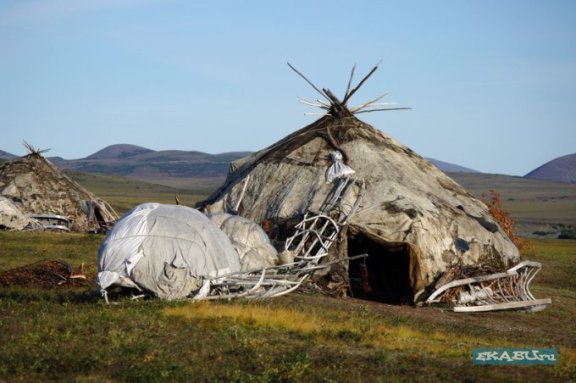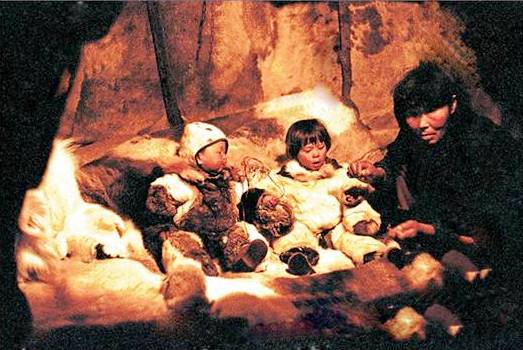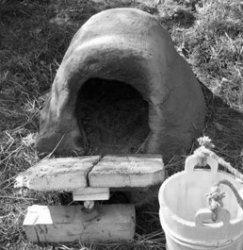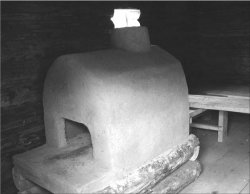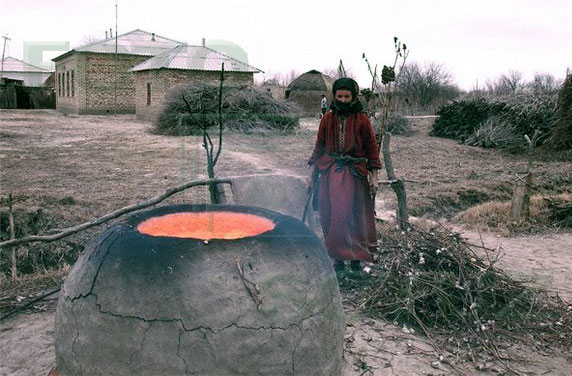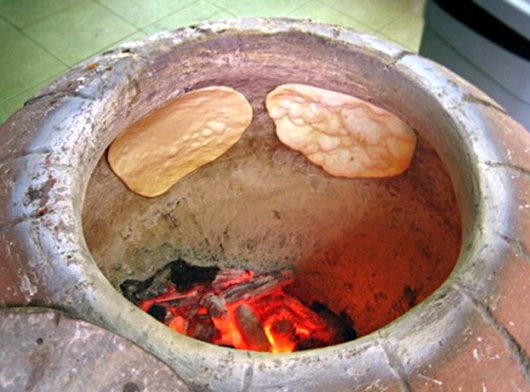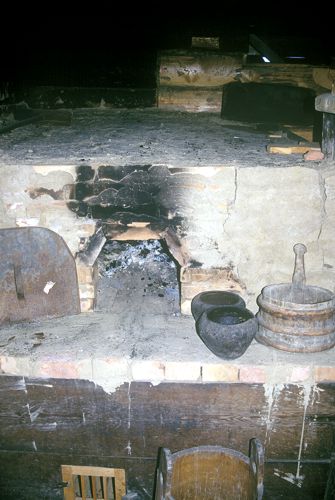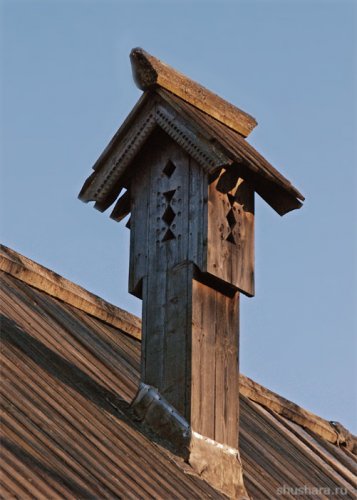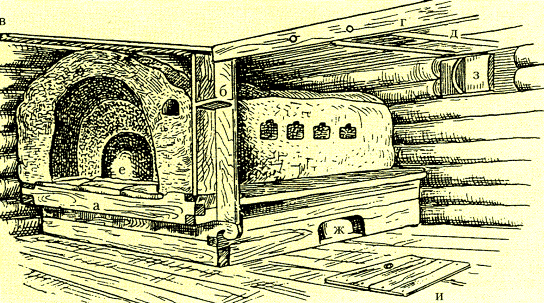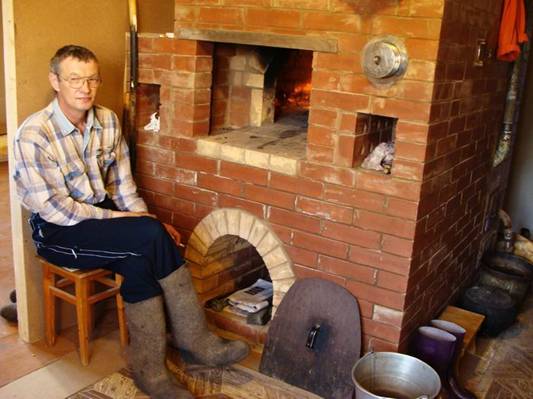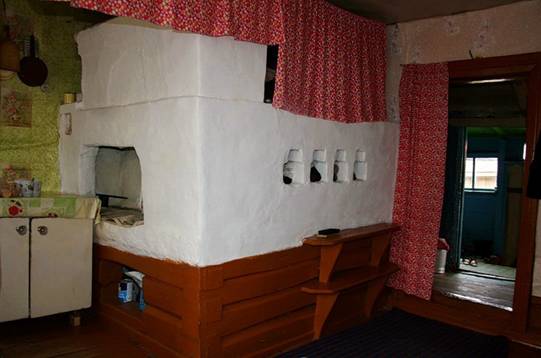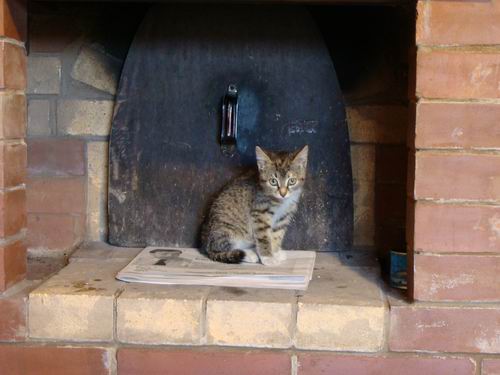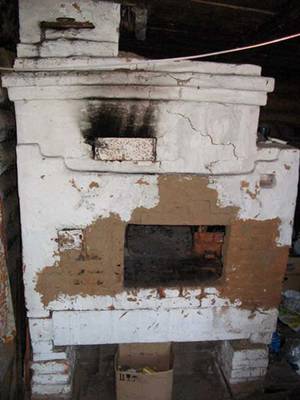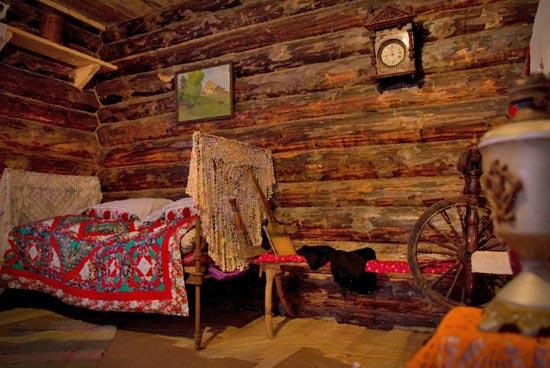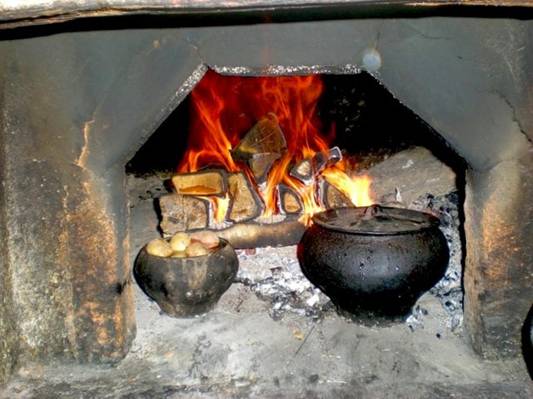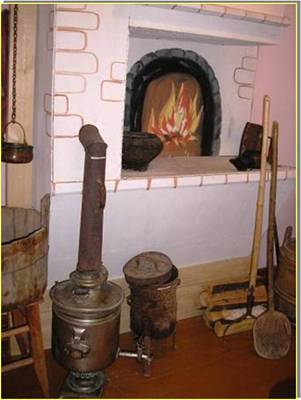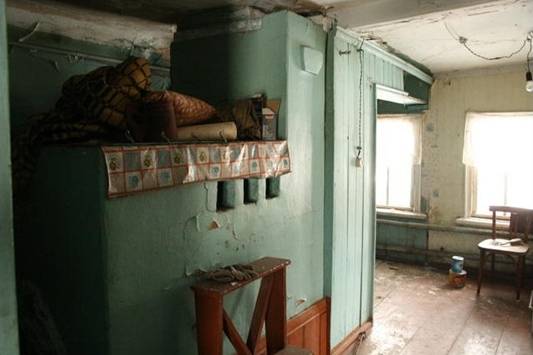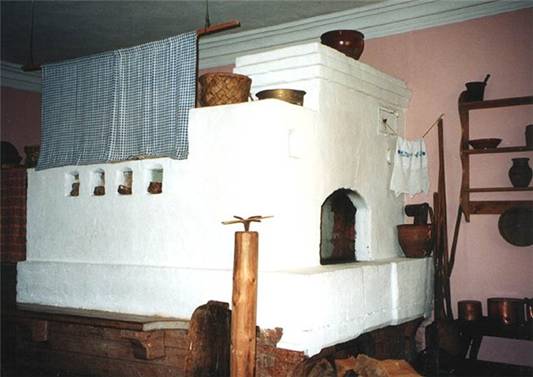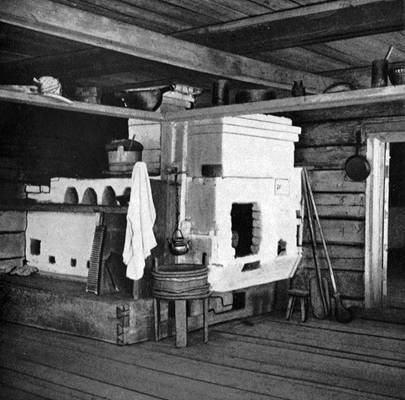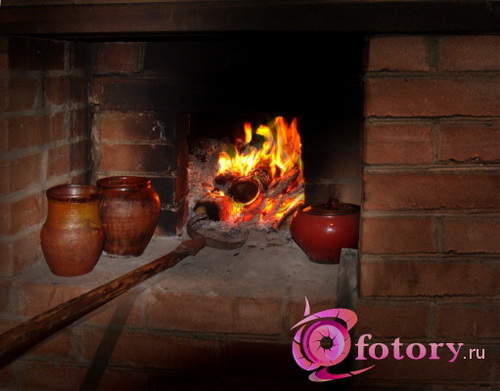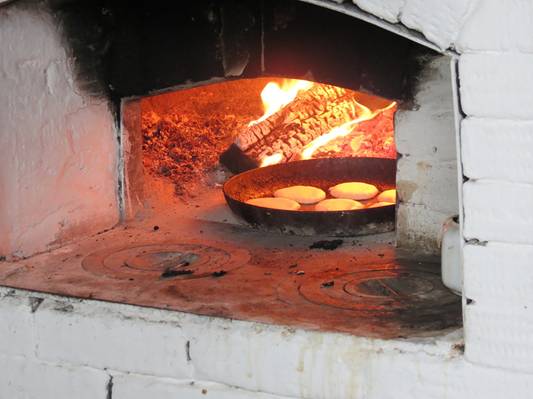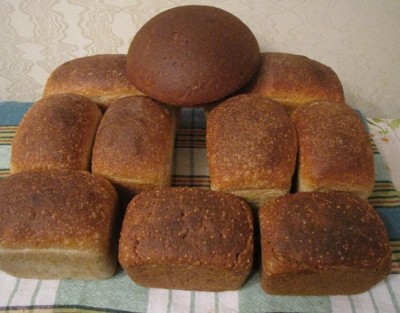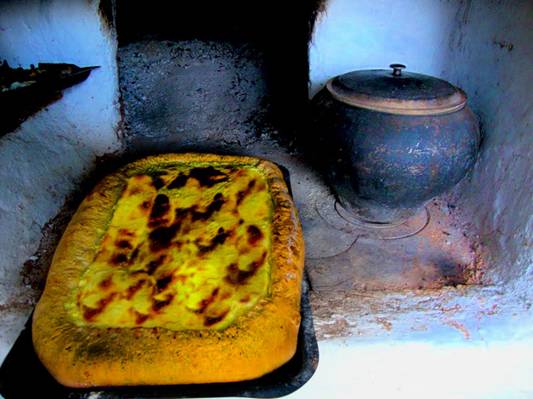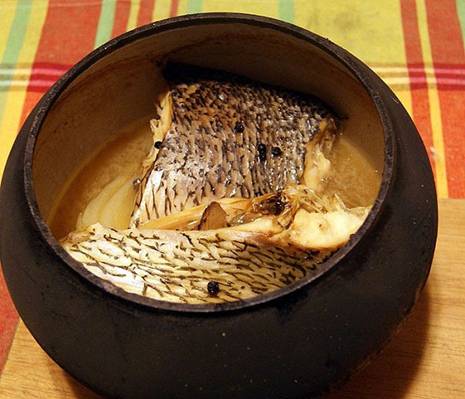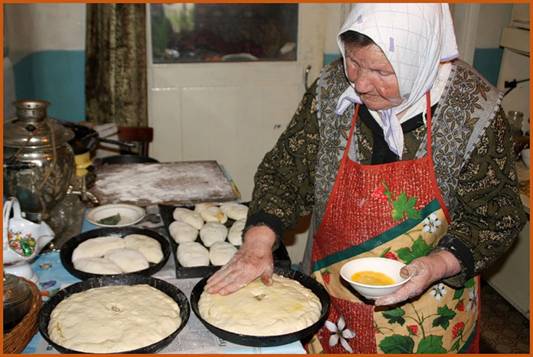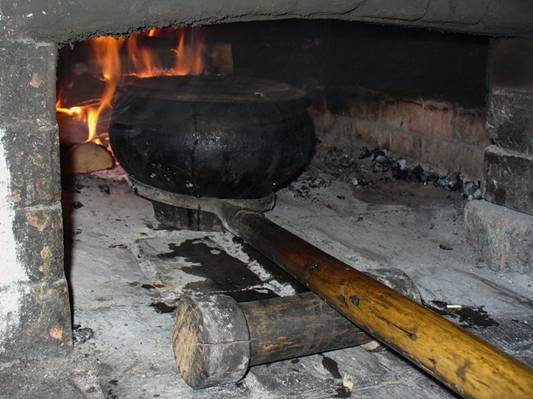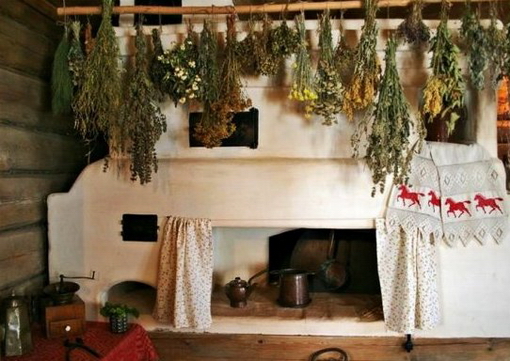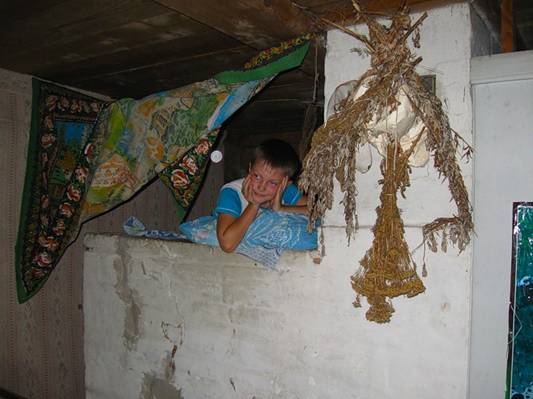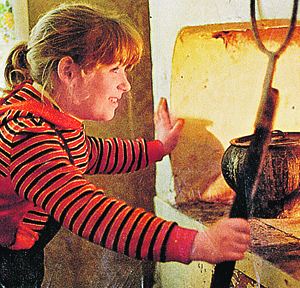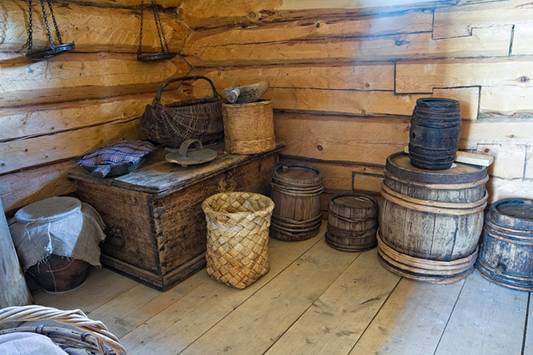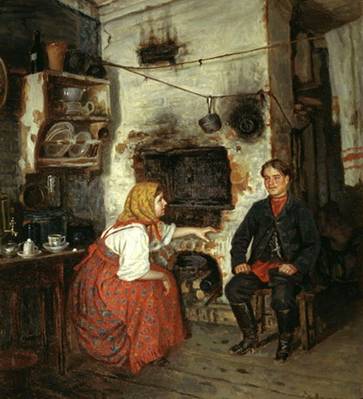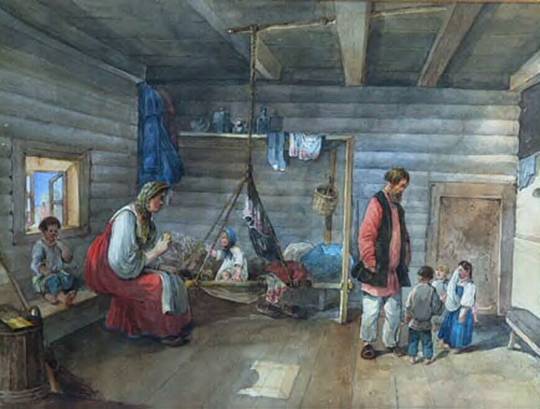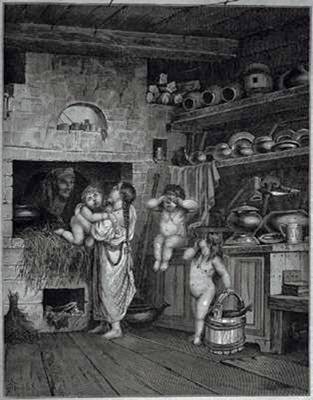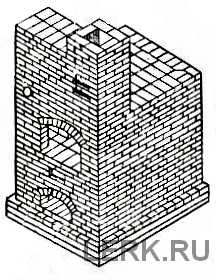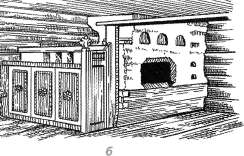Two types of Russian baths: black and white. Kenozerje
To heat a bath in black is not an easy task. Newbies of the bath business, without the necessary knowledge is unlikely to be able to cope. In this article I will talk about how the black bath is heated, how the bathing kingdom is heated.
Unfortunately, the times of the black baths are over ...
But, there are still villages in which there are such treasures. It was into such a village of Korotaevo in the Arkhangelsk Region that my friends went to visit relatives.
How glad I was when I found out that there are black bathhouses in this village! Do not just stand antiques, and constantly heated. The bath is rather old, now they are not chopped up. The whole appearance speaks of the impressive age of the building, which stores even the name of the craftsman who cut down the bathhouse.
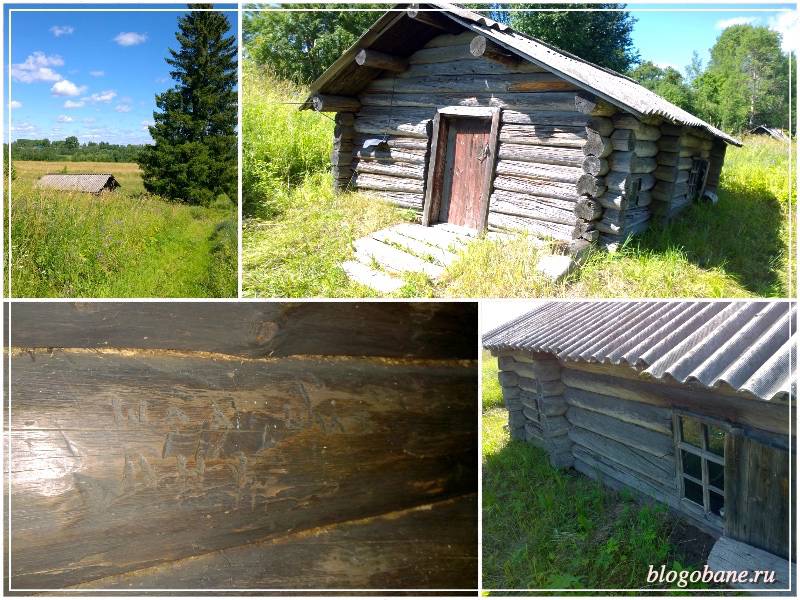
So, I made friends with a recording device and asked to take a video and a bath and how it is heated. I must say that the reporters from my volunteers turned out to be just wonderful! Yes, you can see for yourself that the photos are of high quality, the video was shot according to the rules ...
Baths in the black ingenious invention of the Russian people. Simple, unpretentious building, and everything is thought out in it to the smallest detail.
There is a bathhouse behind a residential building, next to a well - it is easy to take water, it is not necessary to carry buckets of water from far away or to think about connecting the pump.
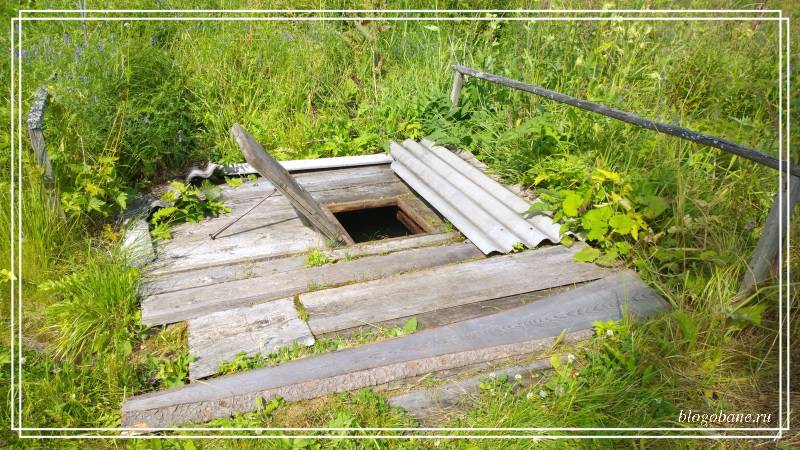 well
well The bathhouse is tiny, sometimes looking at such a building you think: - “How does the person fit there”? And all this was done for nothing ...

A small room is easier to heat. Especially, if not, there has not been and there will not be a pipe from which not only the harmful gas comes out, but also precious heat. What is the similarity of the function of the pipe is performed by the original notion of the Russian man - the outlet.
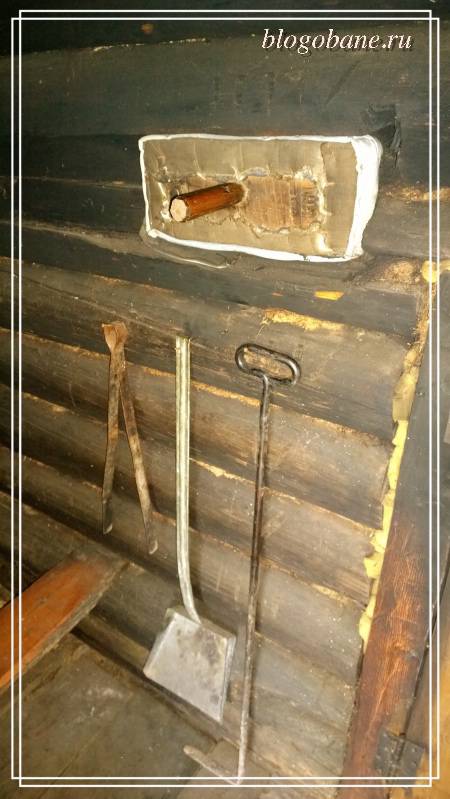
This is a small hole under the ceiling of the bath.
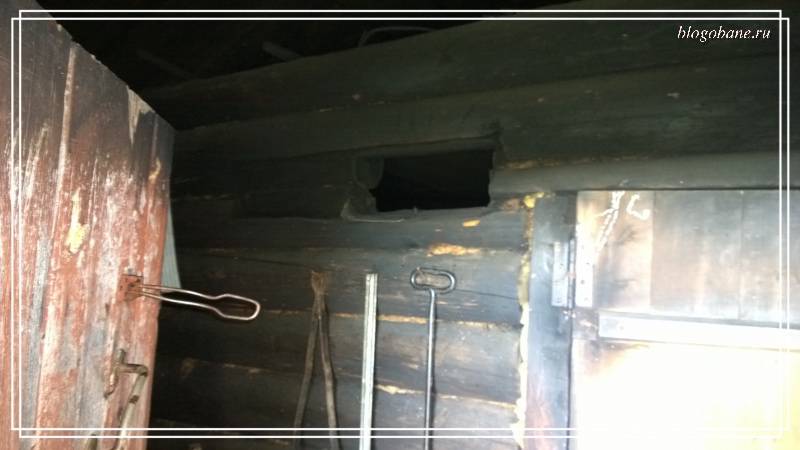
This story began a few months ago. Once, when I opened my mail, I read a letter from a certain Jamie (from Canada), a great lover of a bath. He was going to visit our country in December 2016 and very much requested to find for him a real black-style bath near Petersburg. Unfortunately, at that time I could not help him in the search for a real black bath. But, the theme of baths in black I was very interested ...
I thought - “Have they still been preserved in their original appearance, how are they drowned, how are they arranged”? The report of my friends about his bath completely dispelled the myth that the black-style baths have become obsolete ...
As I said above, everything is thought out to the smallest detail. Look at the doors, there are no iron handles covering the door of the bathing kingdom. Why not!? Yes, because it would not burn your hands when you go to cool after the steam room! And the doors open from the washing compartment to the outside (to run to cool it was more handy)!
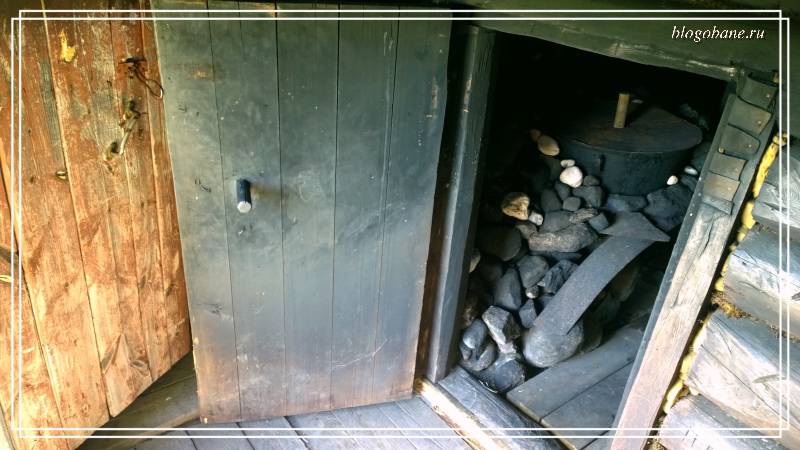
On the cover with a tank of hot water there is also no iron handle-holder, all tricks to preserve human health.
And the tsarina herself bake what! Minimum privileges, decorations and outfits, but what a heat it gives in return! Wow! Wow! And uh!
There is no stone cement masonry in the decoration of the kiln, it is not whitewashed, there is no particular beauty and grace in it. Everything is trivially simple: two huge boulders form the base, an iron sheet serves as a support for a hot water boiler. All unpretentious construction is strewn with stones, which, heated by steam, heat and gases of burning wood, heat a small room of the bath. Yes, and hiss so much that you can hear on the street when you splash water on them!
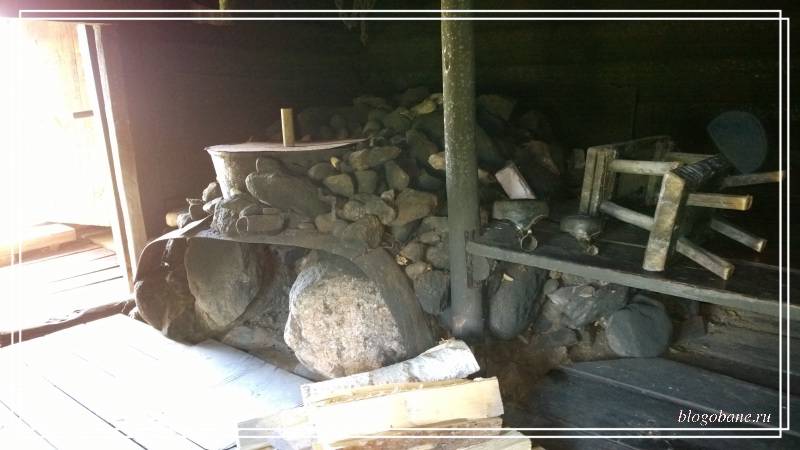
That's all the unpretentious construction of the bath in black. It remains only to add that the shelves in such a bath are not at all high, practically near the floor. But, I assure you, there is plenty of heat on such shelves!
Before you begin the process of heating the bath, you need to draw water in all capacities that are intended for the bath ceremony.

This is done before the bath is flooded, otherwise it will not be possible to enter the smoke room for a long time. Carbon monoxide for a man - a killer!
Like a hundred years ago, a wood-burning sauna is heated. Softwood trees are not the best choice for fire. Almost all of them are resinous, the resin is deposited on the open stone backfill of the furnace, it does not go into the chimney with the smoke, as there is no chimney. Pitch remains inside the bathing kingdom, breathing it is not very good for health.
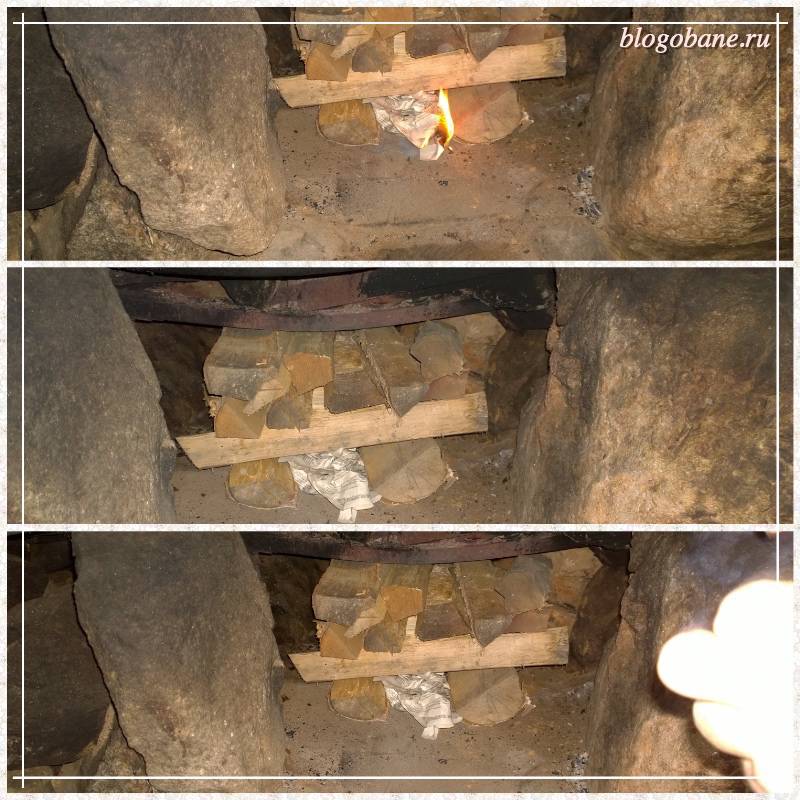
The most optimal choice of firewood is birch. Birch gives heat. Firewood must be smooth, not gnarled, without knots. Knotted logs "shoot sparks" - this is not good at all. We need to think about fire safety. Of course, a sheet of iron creeps near the mouth of the furnace.

When all the details of the firebox process are taken into account, you can also make a fire. As soon as they melted the stove, they ran out into the fresh air! The fire dance itself will do its job - it will heat the cauldron with water, stones and a small sauna room. And he will smoke at his best!
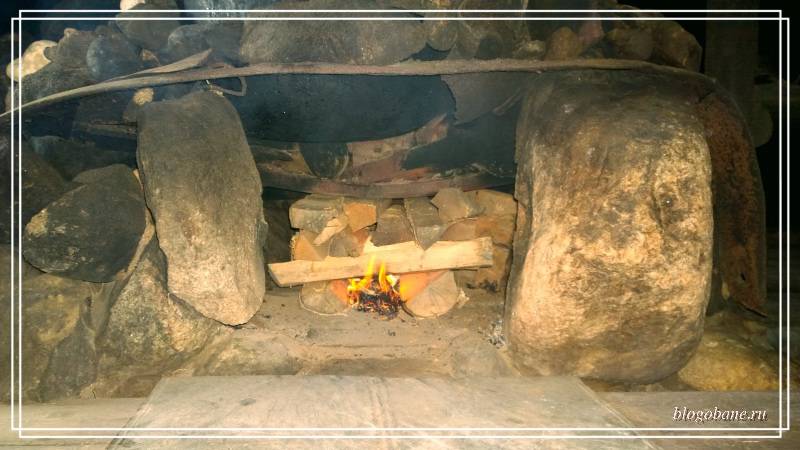
If you look at the bath from the side - smoke just pours out of it, from every gap! An ignorant person, you might think that a bit more and the flame of fire will fly out! But, it only seems that the process of the furnace goes on as usual ...
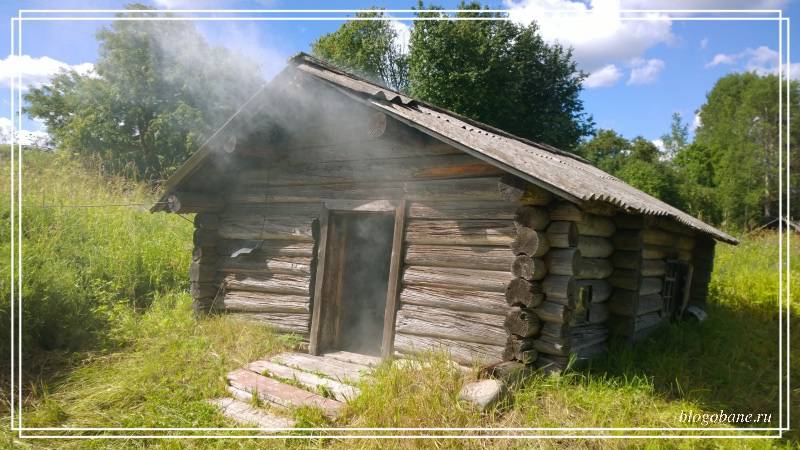
Of course, from time to time it is necessary to visit the bathhouse, look behind the stove, throw an armful of firewood, turn the coal. But visits must be honed, coordinated and transient.
Each bath is individual, each has its own secrets of heating, each is heated differently. For example, the bath of my parents was heated for 2-3 hours, lasted from the smoke for 40 minutes and matured for about 2 hours.
It is possible to wash and bathe in a bath in the black way only after the cleaning works inside the already heated room are completed. This is the time of women's work. Cooled coals and ashes are removed from the furnace's stove. The furnace inside must be clean and clean.
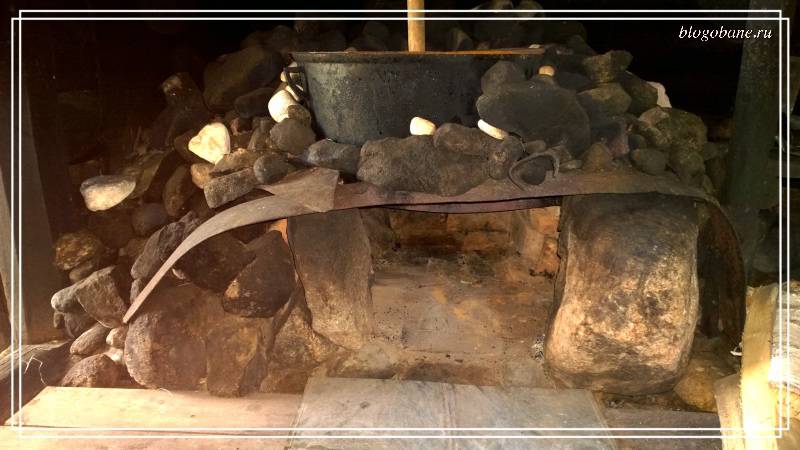
Then shelves, benches, walls, wash basins and floors are rinsed with cold water. Before leaving, you can hand over some hot water to the pebbles, so that the last waste from the stones will go out into the open air. And only after the last preparations the bath can be left to mature.
In the conclusion of the article, I propose to watch a video on how to heat the bath in black. Video filmed by my volunteers in my bath.
The black bath is respected by true connoisseurs of bath art. These were my father, he built it after moving to the village. I was a teenager then, but the memories of her are still fresh today ... In this article I will talk about how to properly heat a bath in the black. But in the beginning there is a little about the features that you should know, since they determine the subtleties of the correct heating. I will tell on the example of our construction.
The “dark” essence of the bathhouse in the black
The construction of the bath is as simple as an ax: it is a small log building with a low ceiling and thick, well-warmed walls (they have a couple of slots with flaps that open when the furnace is melted). The log house is divided into two parts: in one they make a waiting room, in the second - a steam room and a bathhouse. Inside it have a stove, on the upper part of which a lattice is placed, savages are poured on it, and a metal tank or water trough is installed in the gap between the wall and the stove. The main difference between the bathhouse and others is the absence of a chimney. Combustion products leave the furnace into the room and leave it through the window and the door. Because of this, the walls and ceiling eventually become black with soot, the floor remains clean, since the smoke hardly touches it. Thanks to such features, the bath is heated quickly, well and evenly (but this does not mean that it takes little time to prepare).
How to heat the bath in black
First of all, you need to sweep away the room, pour water into the tanks, clean the stove if there are combustion products in it from the last time. Then prepare the firewood. My father preferred birch, but in principle, any are suitable (he categorically did not accept only conifers). An important condition: they must be well dried! Raw burns badly and give a lot of smoke. The process of the furnace looks like this:
The first bookmark of firewood (about an hour and a half to burn out),
The second tab firewood (another hour),
Warming up of the bath and the exit of intoxication (2 hours).
In total, the preparation of the correct bath takes 4-5 hours. Now more.
Stage 1. In the first tab, the logs should be folded so that they quickly inflame. It is not as difficult as it seems, you just need not to fill the furnace tightly with firewood, but to leave between them a space into which to put some kind of ignition paper. It's enough. No fuel to fill is not necessary! The door, windows and gaps in the walls must be open for the smoke to flow freely. From time to time you need to check the stove.
Stage 2 When firewood is burned, you should make a second tab. You can no longer triviality, logs quickly erupt from the first heat. It is better to move around bending down in order not to breathe smoke. When the wood is almost burned out, they need to be twitched a couple of times with a poker. The bright red coals should eventually be evenly distributed in the furnace.
Do I need to make coal?
Often I hear that the bath is almost ready by now, you need to pour the coal and take it out. My father did not recognize such maneuvers and laughed at them. What he (and later me) did: he closed the door and the window, leaving only holes in the wall, giving the bath a “ripen”. After the coals have completely burned through and are covered with white ash, you can clean the floor by opening the doors and windows (you don’t need to take out the contents of the furnace, you should cover it with a damper). After should close them, including the gap in the wall. After 15-20 minutes you can go swimming. As the father explained, the extinguished coals are a sign that almost all the frenzy came out, but it is not necessary to endure them, because they still give off heat. Honestly, I don’t see a logical explanation for the situation: it is clear that the burn out appears during combustion, and the extinguished stove means only that a new gas is not formed. But the fact remains: only under this condition did the father consider the bath ready. If you do not give enough time to exit the frenzy, swimming will turn into a hellish headache and a spoiled mood. Do not be afraid that it cools down, the heat in it will be enough for several visits.
Do I need to wash the walls?
Another point: do not scald before bathing the walls and ceiling, as often recommended. This is supposed to help wash out the soot. Of course, a little bit of soot is washed off, but for the most part the dirt is simply smeared over the surface. If you do not dance in the bath and do not wave the towel, soot will remain where it should be: on the walls. And if they are doused with boiling water, the steam will become wet. For health, the most useful dry. Add moisture can be in the process of washing, splashing water on the heater. Be sure to breathe before it on the shelf with dry, hot air. For the same reason, it is not necessary to pour water on the stones before bathing (this is done in order to “squeeze” the carbon monoxide residue from the room). He will, and so will, if you give the room a good place to stand.
A few words in defense of the black bath
Today, many people do not like a black bath, considering it a relic of the past. The main claims to it:
1. "Carbon monoxide remains in it." In properly prepared it does not remain at all. If it is felt, do not rush into bathing. It is better to wait an extra half hour.
2. "It is dirty, you can get dirty with soot." If you do not rub against the walls and do not touch the ceiling with a broom, nothing like this will happen. Of course, need a habit. After several visits already on the machine, you guard against "dangerous" walls.
I didn’t bathe in a black bath for a long time (there is no possibility), but I miss it and consider it to be the best for health. Of course, before, the grass was greener and sugar was sweeter, but there are objective reasons for my opinion:
Only it has the aroma of "roasted" wood, not everyone likes it, but it is definitely better than the old smell of sweat or dampness, which happens in other baths,
Thanks to smoky disinfection, the air is practically sterile, there is no mold,
You can adjust the humidity by adding water to the heater,
The calcined stones give a lot of heat, sitting near them on the shelf, you can bask endlessly,
A sauna in a black way warms not only the body, but also the soul. It's impossible to just wash and get out. It wants to relax, relax, feel the body absorbs the useful heat. Therefore, if there is an opportunity, be sure to take a dip in “Chernushka” (her father called her so lovingly).
A. V. Galanin © 2012
S. A. Nefedov, V. V. Zapariy, and B. V. Lichman in their article “Technological Interpretation of the New History of Russia” give very interesting reflections on the significance of new technologies for the course of history. In their opinion, the people (ethnic group), who applied the new technology, made a military, political or demographic “spurt”, and even all three spurt together. The situation was balanced, the neighbors also mastered the new technology, and the superiority of this ethnic group disappeared.
Many technological breakthroughs of humanity can be called: the taming of fire; taming domestic animals; inventions - slings, bows and crossbows, wheels and carts, plows, agriculture, wells, boats, saddles, harness, development of metallurgy: smelting copper, then iron, making iron swords; inventions - pants, fur clothes, stone fortresses and walls, battering machines, firearms, boats and sails, a new type of ship with high masts, a steering wheel and perfect sailing arms, metallurgical production in blast furnaces with a powerful blowing system - and many other major inventions. After each such invention, a reorganization of the world took place: some empires arose, others, on the contrary, collapsed.
The domestication of fire allowed our distant ancestors to live in temperate and cold areas, survive several ice ages, the invention of wells allowed them to master areas of semi-deserts and deserts that were previously uninhabited. Thanks to the invention of pants, people could live in cold countries and ride a lot on horseback. The invention of firearms allowed the Europeans to create several world empires - Spanish, Portuguese, Dutch, British, Russian etc.
In Russia-Russia, too, there were many inventions of new technologies, for example: the invention of a special ship for navigation in the waters of the Arctic - Kocha; the invention of the Russian type of wooden house; the invention of the Russian stove; the invention of the manufacture of felt boots; the invention of the technology of baking; invention of sauerkraut technology; cucumber pickling technology, bread kvass preparation technology and much more. This is my story about the Russian stove and its improvement. So, the Russian stove!
A bit of the history of taming fire
The man tamed fire at least two million years ago. At first, he used the fire of the steppe and forest fires caused by lightning. I learned how to support it, save it, move it from place to place. This invention allowed people to settle in colder regions of the globe, allowed them to survive glacial periods at the very edge of the glaciers. Very important persons then were the keepers of the fire, who constantly kept the fire in the dwelling. Fire was worshiped as a deity, it was considered alive because it had to be constantly fed with firewood. The need to keep the fire and thus create conditions for the survival of the family and the race, in all likelihood, is one of the reasons for the increasing role of the woman in the race and the long existence of matriarchy. From hunting, men returned to warm homes, where a fire awaited them, delicious food, and women and children. And the fire kept women.
It became much easier for our ancestors to live when they invented the technology of producing fire by rubbing dry wooden sticks on a dry wooden plank. Then they invented a flint to carve out the sparks that caused dry tinder - small dry chips. A skilled person could make a fire in such a way for half an hour. The dependence of men on women has decreased. Now they could leave the camp for several days and make a fire where they wanted.
Even today, hunters and fishermen, tourists and expedition workers use that primitive hearth (fire). True, the tourists do not carry fire today with them in a special basket, do not produce it by friction or with the help of flint, but produce it with the help of matches or lighters. I want to say that the basis of the invention of matches is friction of one surface against another, here only one surface ignites from friction very easily (a match head). The lighter is the native daughter of flint: from a blown spark ignitable gas or gasoline ignites. The fire played a very important role in the history of mankind, it was idolized and romanticized. Even today, songs are written about him: “Soar blue fires at night ...”, “So the fire sparkles scattered ...”, “Our fire shines in the fog, the sparks go off on the fly ...” and others.
The man guessed to “drive” the fire into his home for a very long time. At first it was an ordinary bonfire in the middle of the plague. It was called a hearth or gome. Such comels today are used in the tents and yarangas of the inhabitants of the Far North. Such a hearth is surrounded by stones in a circle, which, warming up, store heat for a long time when the fire has already gone out. On such stones the kettle or pot in which the food is cooked does not cool down longer. Such a focus among all nations was considered and is considered sacred. I saw in the tundra of Chukotka that the nomads of the reindeer herders, coming to the place of the old site, put a yaranga on the same places where she once stood the last time, while necessarily using the stones of the old hearth. Most often, the yaranga was placed in the same place where its predecessor once stood. The stones of the hearth of each kind were their own and were considered sacred.
When the Russians arrived in the mouth of Anadyr in the 19th century on a ship to choose a place and lay the future city of Anadyr, they turned their attention to the Chukchi camp on the southern shore of the Anadyr estuary. Anchored, sent a boat, asked the Chukchi: "Do they live here all the time?" Having received the answer: "Yes, constantly." Landed and laid the settlement. A couple of months later, the Chukchi removed the yarangas, loaded them onto the sledges and left. They were fishing in this place and always, when they were fishing, they put yarangs in this place. But they caught fish only 2 months a year. This is how the city of Anadyr was laid in the most inappropriate place to live. And still he stands there.
|
The hearth in the Chukchi yaranga. Photos from the site: personalguide.ru |
Chukot yaranga. Photos from the site: miss.ekabu.ru |
Firewood in the tundra is a big problem, only on a small camp you can gather thin willow branches or alder bushes and birch trees in the floodplain of the river to cook food on it. In the tundra with wood you will not warm your accommodation. Therefore, a completely different culture of life has developed there, another Arctic civilization that does not use fire to heat a home. How, in the North, in such a winter in the winter and not to warm their homes with the help of fire? Yes, it is simply impossible! But it turned out to be possible. A resident of the Far North went the other way in this matter.
|
In the canopy in the Chukchi yaranga. Photo by Victor Zagumyonnov from the site: http://photopolygon.com/snaps/details/8583 |
The inhabitants of the tundra learned to live without heating their homes and therefore mastered the Arctic, with its endless reindeer pastures. And they did it very simply: they invented special, very warm clothes from deer skins with fur inside, mittens, hats, shoes, which allowed them to even sleep in the snow in a forty-degree frost. They learned to keep their body heat, and this, as everyone is well aware, is +36 degrees Celsius. In the northern tundra nomads, the hearth of the yaranga or plague mainly serves for cooking, its role in heating the dwelling is small. Warm in yaranga is a canopy made of deer skins with fur inside, in which they both sleep, and tell tales, and talk, and make love, and give birth to children, and die. There is no firewood in the tundra; therefore, they did not invent heating furnaces, but sewed warm clothes, arranged warm canopies. Using such technologies, people could survive the ice age, and not just one, but at least for the last million years, three ice ages. Heated space in the canopy with the help of his own bodies (people in the canopy are stripping naked). For illumination, they used grease box - a lamp, in which on the wick there was burning seal oil. |
Such an arctic technology of life support has allowed the inhabitants of the Arctic and Subarctic to survive the ice ages, master the tundra, survive, preserve and pass on their genes to us.
The inhabitants of the taiga zone had a lot of firewood, so the development of a civilization of taiga hunters and fishermen went the other way. They began to improve the heated dwelling, but at the same time they did not forget about clothes, hats and shoes. We started with a hut and half-earthen houses, in which they organized fires like fires, placing them away from the walls - in the middle of the dwelling. But it was flammable and not very effective. A little gap, and the fire will go to the walls and roof. The hearth, to warm the home, had to burn constantly, and for this, someone had to support it. Those who spent the night in taiga huts with stoves of stoves, know how quickly they stand up in a hut in winter - as soon as the stove stops burning.
To create comfort, our ancestors carefully made the walls in the huts, invented a warmed floor, a ceiling and a warmed door. For warmth, it was made small and low so much that they entered the hut bent into three deaths - they literally crawled almost on all fours.
Warming the walls, ceiling and floor, do not forget to improve and the hearth. For this, it was made of stones and massier. The stones heated up and then gave off heat for a long time, warming the dwelling. Almost without changes, such an ancient center is being arranged today in the black-bath baths. Once the dwellings of our distant ancestors were similar to these bathhouses.
Where the wild stone was not invented a pise stove. They made a frame of stakes and rods, it was covered with a thick layer of mortar made of clay and sand when the product dried, it was set on fire, while the stakes and rods burned, and now the stove is ready. When it began to sink, there was firing, and the clay with sand turned into a solid stone. The style of the clay ovens was very different.
|
The oldest clay oven probably looked like this. Such a butt could warm a dugout or a cave. It was possible to cook hot and cold smoked fish on it. Picture from the site: http://apxiv.ucoz.ru/publ/istorii_bit/1/russkaja _pech / 14-1-0-135 |
This adobe oven can still be seen in some courtyards in the villages. It can burn garbage, bake potatoes, cook soup in a bag, etc. Long ago such furnaces were arranged in dwellings. Picture from the site: http://apxiv.ucoz.ru/publ/istorii_bit/1/russkaja _pech / 14-1-0-135 |
Pise stove in the bath in the black. If you splash on such a hot oven, there will be a lot of hot steam. This stove looks quite aesthetic. Picture from the site: http://apxiv.ucoz.ru/publ/istorii_bit/1/russkaja _pech / 14-1-0-135 |
The settled peoples had more permanent dwellings. They placed the fire under the clay vault. A primitive stove made of wild stone covered with clay was probably invented back in the Paleolithic. Such komelki arranged in dugouts and caves.
|
Kipchak stove - tandyr used for cooking. Such furnaces were used where there was a shortage of firewood, where such branches were used for firewood. At the bottom of this large pot, air enters through a small hole. Photos from the website: transit-club.com |
Tandoor is placed not only in the yard, but also in the house. The famous pita bread is baked in tandoor. Photos from the site: livemaster.ru |
Another type of stove, mainly for cooking, and not for heating a home, was chosen by the sedentary inhabitants of the steppe and forest-steppe regions, this is the so-called tandoor. A tandoor is also a wattle and daub, similar to a large pot. There are many modifications of tandoor. I think that the one who was born and grew up in those regions where they are used will write about tandoors better.
The stove of the northern forest dwellers served two important functions: cooking and heating. At the same time, heating, especially in winter, was even more important, since food could also be cooked on a fire outside. Firewood in the forest area in bulk, only harvesting do not be lazy.
Russian stove in black
Russians - the inhabitants of taiga have created their own special lifestyle, another civilization, the basis of which is a house with a special Russian stove, the good of wood for building a house and heating in the taiga was enough. Masonry stoves in Russia since ancient times was at a high technical level. This is evidenced by the design of the chicken (without chimney) hearth, which was widely used in ancient Russia. Such a hearth became the prototype of a perfect universal device known as the “Russian stove”. At first, the Russian stoves were fueled in a black way, which made the huts called chicken houses.
Initially, the Russian furnaces were mud and had no pipes. But already in Ancient Russia in the X century. There were Russian brick stoves with a brick pipe. And the age of the furnace in black, in all likelihood, has a few thousand years. Pise, or "broken" furnaces are more reliable than brick ones, they keep heat better, do not dampen, do not burn through, over time only gain strength, turning into a single shaped brick, which is difficult to break even with a crowbar. Clay on the stove was taken not far from the village, and sometimes, if the clay layers came close to the surface of the earth, it was also in his goalstick. Used ordinary red clay, plastic, but not greasy. Old-timers beating the stove were timed to the full moon, so that later it would not crack and dampen. But not only clay is used when laying stoves. A solution consisting of 2 thirds of pure sand and 1 third of clay is used. If there is more clay, then the kiln will crack, if there is more sand, it will crumble.
The smoke from the stove entered the hut, here it gave off its heat and already fairly cooled down through a special window in the ceiling under the ceiling and went out into the street. In the 14th century, furnaces in chicken huts began to be constructed with a wooden chimney, a chimney. Smokeboxes were made of thick boards, but they did not move away from the furnace, but at a rather large distance from it. Through such a wooden smoke box, the street was already quite cooled.
The disadvantage of such furnaces is that there is a high probability of a fire from a spark, therefore it is impossible to make very strong fire in the furnace so as not to cause burning sparks flying from the mouth. To do this, you must always monitor the intensity of burning wood in the furnace. To stoke the stove in black is a great art, a great skill is required. The hostess, who does not know how to heat such a furnace, could suffocate from the smoke in the hut, and could kill the household, or even make a fire.
And if you stoke such a stove in a black way with intelligence and knowledge, the smoke, coming out of the stove through the mouth, rises up to the ceiling and moves in a thin layer towards the open window under the ceiling, giving all the heat to the air in the hut. Skillful housewives in chicken Ibah did not even accumulate soot on the ceiling, and the walls in the hut were not smoked at all. In addition to the noted drawbacks associated with the fire hazard and the smell of smoke in the house, the henhouses had great advantages. Hot air and hot smoke from the stove gave all their heat to the hut, dried and warmed the air, created a very healthy microclimate. The air, the ceiling and the walls in such a hut were disinfected, which was very important for combating infectious diseases and unpleasant insects. And having hung fish or meat under the ceiling, it was possible to smoke them in cold smoking mode.
|
Black stove in the Velsky district of the Arkhangelsk region. On the pole there are clay pots in which food was cooked, and wooden pot for making dough for bread. Downstairs near the stove there is a tub (tub with ears for carrying on a threaded stick) with water. Photos from the site: http://vse-znat.ru/istoriya_poleznich_veschey/russkaya_dusha_russkaya_ pech.html |
Smoky house and black oven. This is a Russian stove, only without a chimney. She has a separate foundation and wards, and in her side stoves. The furnace is loaded with wood and pots through the mouth, through the mouth and smoke comes out. The walls in the hut are clean, only the ceiling is smoked, which means that the hostess is skilled. As a child in the early 50s of the last century, I was lucky to see a real Russian black oven in the village of Redyukino. It was probably the last such stove in the Yaroslavl region. She stood in the back hut potter's house - in his workshop. He used this oven to dry and bake clay products - pots, rats, korchag, plosek. They were dried on wide shelves along the walls, and the firing took place inside just such a furnace. Photos from the site: http://vse-znat.ru/istoriya_poleznich_veschey/russkaya_dusha_russkaya_pech.html |
Furnaces with a pipe in Russia began to do when mastered the manufacture of bricks. But people did not immediately abandon the black ovens. A stove with a chimney and a pipe is less economical, it requires more firewood, since the heat with hot smoke goes, as they say, into a pipe - by heating the streets. In addition, the hut is not disinfected, and sparks from a pipe on the roof are very dangerous, especially in windy weather. Roofs used to be covered with straw, shingles, and in dry weather this material could ignite from the slightest spark.
Modern people think that if they drown in black, then all the walls will be smoked, and the residents of such a hut will be smeared in soot like Cinderella from Andersen’s fairy tale. The ethnographers who described such huts in Russia invariably were surprised to find that the walls in the chicken houses were light, and only the ceiling and walls were smoked down a flat line of 20-30 cm down from it. You just had to be able to choose the right firewood and follow the mode their burning in the furnace. To avoid soot and soot, carefully chose the type of trees, harvested and stored firewood. On the kindling used dry pine, aspen or alder. And when the wood in the stove is well inflamed, they added logs of spruce and birch.
Soot accumulated only at the top of the hut of the hut or near a special “top” (the so-called portage window, that is, a gap made in the wall into the diameter of the log, which, when the furnace was not heated, was closed with a gate valve).
Black ovens were widespread among Russians in Siberia in the 17th-18th centuries. even among the nobility. For example, such a furnace stood in the private chambers of the Tobolsk Archbishop Cyprian. The stove without a chimney, made according to "all the rules", is now valued by chaldon, only they prefer to arrange it in the bath. In their opinion, it possesses many positive properties - it boils more, compared to white stoves, its economy in the consumption of firewood. Siberians also note the healing, "disinfecting" properties of black furnaces.
Please note that the Russian black oven does not have its own foundation, it stands on the floor. The load of its weight falls on the floor translations (beams). Wards made of thick boards or scaffold.
Over time, the firebox in black changed the firebox in gray - smoke began to be released through the hole in the ceiling and a wooden pipe. From the chimney strongly cooled smoke dissipated in all directions. It was very dangerous to release hot smoke with sparks, as the roofs of houses were often made of straw, and in dry weather they flashed from the slightest spark. So the hut in black is not the inability of our ancestors to invent and build a fireplace with a chimney, but a way to live in heat without causing a fire.
Black huts had a significant height. It gave a lot of space for smoke at the top. "" Excessive "" volume did not disappear in vain: things that were not afraid of soot and needed periodic disinfection were hung to the roof beams to dry, so that rot (for example, nets), as well as some products that were not harmed by "smoking" ". Dry, warm air is characteristic of a black log house, it was easy to breathe there, because when you burned the hut it was aerated: you had to open the door. The smoky huts very rarely dampened, besides the smoked tree was not rotting. And finally, the “black” “pipeless stove” required less firewood compared to the ““ white ”“, gave more heat.
In 1718, Peter I issued a decree prohibiting the construction of houses in St. Petersburg with chicken ovens and wooden pipes, and in 1722 this decree spread to Moscow. Consequently, until that time, the Russians heated their houses in the black even in the capitals. Russia began to imitate Western Europe, everything began to be ridiculed, seem bad and primitive. Peter I forgot that the climate in Russia is not at all the same as in Holland or England. After his decree, the number of colds in St. Petersburg increased dramatically. A pulmonary tuberculosis for residents of St. Petersburg has become a widespread disease. But thank God, the villages and villages did not touch Peter’s decree, and in the northern villages they continued to make black ovens until the twentieth century.
|
Tesovaya pipe to exit smoke from a hen house in the Arkhangelsk region. To rain and snow did not fall into the attic, the pipe has a roof. And he could not have a Russian without beauty, he even carved a chimney. Photos from the site: http://www.perunica.ru/istoria/679-istoriya-russkoj-pechi.html |
The Russian stove in black had variations. It was possible to sleep on such a stove as well as on an ordinary Russian stove. Photos from the site: http://www.perunica.ru/istoria/679-istoriya-russkoj-pechi.html |
Russian stove in white
At first, Russian stoves appeared in white in the houses of rich people — boyars and princes, but by the 17th century they were widely spread among the middle class. The main center of kiln art and the training of masters of kiln affairs in the period from the time of the creation of the Russian state to the second half of the 17th century. were the cities of Vladimir and Moscow. Here progressive designs and new architectural forms of heating furnaces were born, the technology for manufacturing stove tiles was developed, brick factories and iron foundries were built, which made stove devices — gate valves, doors, tongs, etc. In the XVIII century, brick production became widespread, at this time many churches were erected in cities and villages. But the Russians were in no hurry to abandon wood as a building material. Both rich and poor were building logs from logs. In house building, if brick was used, then the first non-residential floor was made of it, and the second floor was a residential floor. For a long time, both stone and wooden churches coexisted in the same village next to each other. The stone cold church was summer, and the wooden one was warm winter.
I was born and raised in a Russian house with a real Russian stove. The fact that many today can only be seen in the museum has surrounded me from birth to 17 years, and even then I often and for a long time visited the house of parents who, until the end of their days, tried to live in Russian. And today my brother lives at home in a Russian house with a Russian stove, in Russian. Now in the course of the name for the successful in the lives of fellow tribesmen - "new Russian". That is the name of those who are rich and want to remake Russia in a Western way, for whom Russia associates with a mosquito, backwardness, who reaches out for someone else, without really knowing this person or theirs. But today I will talk about "real Russians" who may not be so rich, but who wish to preserve Russian national culture, Russian customs, Russian language. I really want the real Russian to always be more than the new Russian.
And for this, I will not tire of proving and explaining how much beauty was in our traditions, in our folk art, our Russian technologies. Maybe I will be able to convince someone from the "new Russians" that the Russians have never been a backward nation.
|
The stove occupies a central place in the hut. It is optimal for heating. Two stoves for drying mittens, storing matches and spins or bark for kindling. There are brick walls, but under the pole there is a place for storing firewood and in the back of the groove - a manhole for a cat, through which she can go underground to relieve herself and at the same time catch mice, thus protecting the underground potatoes and vegetables. Right above the stove a hole covered with a tin lid. It is intended for a samovar pipe. Photo A.V. Galanina |
Russian stove on wooden side with four stoves on the side - for drying mittens, socks and sisters. Staircase with two steps, which can be climbed to the stove. The wide mouth, hearth and under the hearth hole, through which the cat can walk underground. Photos from the site: http://clubs.ya.ru/4611686018427414778/posts.xml?tb=250 |
Not from stupidity, the Russian peasant continued to build wooden houses, preferring them to stone, but he did this from a good knowledge of the laws of thermal physics. In Western and Southern Europe, the winter is warm, it is possible there and in the stone house does not freeze. And in the Russian north in a stone house in winter full "kirdyk", and if you drown up to a good heat in a stone house, you will not get firewood. Judge for yourself: if the stone is heated from one end, it heats up quickly and the other, since the stone conducts heat well. But if you fire a splinter, you can hold the other end until the fire comes close to your fingers. It does not warm the tree, but the stone holds A wooden wall made of wooden beam 15 cm thick retains heat better than a brick wall 1 meter thick. Well, on panel concrete walls 35 cm thick, I am silent. They don’t keep the heat at all: if the batteries in the panel house cease to be hot (they turn off heating in the winter at 30 degrees frost), then in half an hour the apartments will have a negative temperature, and in 3-5 hours the temperature in the apartment and outside will even out. And we wonder: and why the heating of apartment buildings in cities costs so much?
If in Leningrad, people were living in blockade in a blockade, then nobody would live until the middle of the first blockade winter. And in the old Leningrad houses there were thick brick walls, and the stoves from pre-revolutionary times survived. Furniture and books, but it was possible to warm at least one room. Today they are building a lot, but all the new buildings are without furnaces. And just in case of emergency would not prevent the stove. Why are there stoves, at least staged chimneys. Hey! MES, where are you? Why do not you prepare for the Duma a draft of such a law so that in case of an emergency furnace or at least builders make chimneys in apartment buildings on a mandatory basis?
And our ancestors knew that in Russia in winter heat in the house is more important than food and even clothes. And they created for this perfect Russian stove in white. Russian oven is more perfect than all furnaces in the world. It is multifunctional, economical, easy to operate and fire safe. This is what my further story will go about.
|
The mouth of the Russian stove is closed with a damper with which the stove is closed when it is not heated. A firestone brick: it continues smoothly in the kiln, laid out of the same brick. There should be no irregularities on the hearth and hearth, they will greatly impede the movement of cast iron and pots. In winter, the hearth is a very warm place, cats love to bask here. Photo A.V. Galanina |
The smoke from the Russian stove comes out through the mouth and goes to the shell, where it makes two or three turns and then rises up through the chimney to the attic. As a rule, the Russian stove has two valves that block the chimney. One of them is in the skin, and the second is higher on the tube. When the furnace is heated, the valves close the exit of warm air. On the left you can see the hole closed by a small cast-iron door for the samovar pipe. The oven, although it has a shabby look, is folded according to the rules. True, now she was in an abandoned house. Photos from the site: http://unwd4.narod.ru/ko/voria/voria.html |
The Russian stove is fired with firewood (birch, aspen, linden, pine, spruce, alder, and other species); woodworking wastes can be used as firewood: wood chips, slabs, measles, etc. In the treeless parts of the country, where only wealthy families could afford to be heated with wood, the furnace was drowned with weeds, straw, reeds, as well as peat and dung (pressed and sun-dried briquettes from a mixture of manure and straw). The hottest firewood is birch, and the smokeless ones are alder and willow. Dry firewood is many times more efficient for heating than raw. The good owners impaled the wood under a canopy dried for 2 years before they began to use. Such wood was required 2-3 times less than raw or undressed.
In the Russian stove, food was cooked: boiled, steamed, fried, baked and “tomili”. For cooking they used pots, pots, bowls, goosebells, potties, pans, trays. And in order to put something into the oven and take out of it, they used tongs, pans (heels), wooden shovels. Obligatory attribute near the furnace were: cranberries or poker, capacity for extinguishing and storing charcoal, which were removed at the end of the furnace from the furnace. Cookware used to be made of clay, but then for the most part used metal pots of cast iron - cast iron, but clay pots and pots were also used. With the stove, in addition to 3 tongs and a skillet, there were 2 more pokers for mixing the coals and scooping the ashes, a metal scoop - scooping the coals. In addition to heat and cooking food, the stove produced charcoal for boiling the samovar and ashes, which were used for washing clothes when there was no soap, and for fertilizing vegetable gardens. The ash was put in a special container in the yard - an ashpit. In the villages, neither coal nor ashes were ever thrown onto the road. Therefore, the snow in the village was clean until spring. Not that today in the cities!
|
Each master stove-maker contributed something to the design of the Russian stove. This one here made a convenient shelf-table in front of a pole and a wide shoulder (in between the skin and the wall). A coal iron, to iron clothes, appeared in the early twentieth century and replaced all-metal, which had to be heated on the stove and ironed. But he quickly cooled, and again it was necessary to heat up. And burning coal was loaded into the coal, and it was not necessary to put such an iron periodically on the stove. When I went to school, I stroked my pants with such an iron. |
It looked like a Russian hut in the northern villages in the first half of the last century. An iron bed, a patchwork quilt made from multi-colored pieces that remained after cutting. Many of my peers, who grew up in the villages, covered themselves with such blankets. The walls in the Russian huts had never been painted or plastered before, but from time to time the tree really acquired such a brown color. Shelves, benches, benches - they all did it themselves. Purchased furniture in the houses was very small. |
I will try to prove that the Russian stove is a really brilliant invention. I am struck by its simplicity, efficiency and versatility at the same time - three in one, as they say today. Her invention and improvement played a very important role in the formation of the ethnos "Russians". Previously, I already wrote that the Russian nation was formed around the cow. And now I will try to justify that around the Russian stove too. No wonder we have a favorite and not yet forgotten expression - "We must dance from the stove." This means that it is necessary to do something important thoroughly, based on all the accumulated experience, from the very beginning.
|
Russian stove in action. Together dry firewood. Smoke exits through the mouth. In the pot cooked: in one potato, in the other, I suppose, soup or borscht. Northern Russians cooked cabbage soup, while southern Russians preferred borscht. All of us beloved and today the indispensable potatoes in Russia appeared only in the XVIII century. She ousted turnips. Before the potatoes, the Russian people ate steamed turnips and cooked porridge: barley (from wheat), barley (from barley), oatmeal, buckwheat. From the steamed turnip was prepared a special dish - turnip casserole. Sugars consumed very little, instead they ate dried and pickled berries, drank bread kvass. In a Russian stove in a large cast iron, boiling water was used to prepare the cattle: they brewed root crops with mixed fodder. When the firewood is completely burned, the cast iron moves deep into the stove, and there the food stays hot until lunch and even until evening. It is not necessary to warm it up for lunch and dinner. In the oven, closed by a damper, the heat lasts until the night. Photos from the site: http://shcherbina.livejournal.com/247676.html |
Put the boil samovar. Coals are superimposed into the pipe in the central part of the samovar. Around the pipe in the samovar water tank. The coals are lit, the smoke from the samovar goes through the pipe into the chimney stove. Excellent, and the bucket samovar boils in 15 minutes. Each time after burning the furnace, the coals are raked out of it by a poker and put a shovel into a special metal or clay container. The access of air to burning coal is stopped by a tight lid, and they quickly go out, having consumed all the oxygen. Capacity for coal is on the right of the samovar on the legs, so as not to burn the floor. To the left of the samovar is the tub and wash basin. On the right is a gripper for cast iron, a shovel for baking sheets with pies. Photos from the site: http://edu.of.ru/usschool/default.asp?ob_no=29421 |
In the Russian furnace, the internal surface of the bricks and the air during the fire is heated to 200 degrees Celsius. The high temperature in the furnace can be kept for hours without additional heating of the furnace. Cooking is the perfect setting.
Absolute technological excellence Russian stove reached in the XIX century. Unfortunately, little is known about the perfection of the Russian stove, and if it is known, then our Euro lovers are silent. So, the new Russians in their ridiculous cottages are building primitive pockets of fireplaces, in which everything is warm, without stopping, flies into the chimney with dangerous burning sparks.
At the end of the 15th century and in the Russian villages, the adobe furnaces began to be supplanted by furnaces made of brick. Our ancestors learned to burn brick, set up brick factories in almost every village. Around this time, the roofs began to be covered with shingles or saws, which is why the likelihood of fires sharply decreased. Soon a chimney appeared in the Russian stove, while the draft became much better, but the heat loss with the release of still hot smoke increased many times, and the risk of a fire also increased significantly. In order to increase the efficiency of the Russian stove, a curved tube with revolutions in the skin was invented. While the smoke goes through all the chimney wells, it gives off heat to the bricks, and the sparks go out. In the attic, before releasing smoke into the sky, it is allowed to run along a horizontal pipe segment - the so-called boar. So when the smoke comes out of the chimney on the roof, it is no longer hot, but just warm. In such tubes, crows sometimes even nestled and hatched chicks. At the same time, the stove suddenly began to smoke, the smart owner, before starting to clean the pipe from soot, climbed onto the roof and checked whether there was a raven or a dirty nest in the pipe.
One of the reasons why for a long time stoves were heated in the black way is the high cost of bricks. Only very wealthy people could afford to use it, so for a long time the “black” stoves remained in operation, and they drowned in the choir of princes and boyars in a white way. The Russian stove with a brick pipe is called “white” and, accordingly, is drowned in a white way. The design of the Russian stove with a pipe turned out to be so successful that since its inception it has not changed fundamentally, especially in the countryside. Improved only its individual parameters. The fired brick was really very expensive, so the peasants often made kilns from unbaked bricks — raw ones, and made kilns from baked ones just under the kiln’s vault. I think, for clarification, it is enough to cite two examples from Russian history.
In the XVIII and early XIX centuries. Russian kiln art has spread in Western Europe. The history has preserved some of the names of prominent Russian stove-makers of the time: Martyn Vasilyev, Yermolai Ivanov, Ivan Stepanov. Types of Russian stoves then spread to Germany, France, England. Until the middle of the XVIII century. stove heating equipment developed and improved solely on the basis of the centuries-old experience of the Russian people. The scientific basis for the design of furnaces and furnace heating systems was laid by N.A. Lviv (1751-1804). I.I. Sviyazev in the XIX century. studied and tested the design of heating equipment, he theoretically justified the methods of its design, invented the original types of furnace. In 1867, he published The Theoretical Foundations of the Kiln Art, in which he cited a method for calculating the length of gas channels and chimney sections. In 1880, Professor S. B. Lukashevich published the “Course of Heating and Ventilation” and in the section “Stove Heating” laid out the theory of calculating heating furnaces.
Often the Russian stove was located in the corner of the hut, on the left or right of the entrance. The mouth of the furnace was facing the wall opposite the entrance and was lit by a side window. The stove was very close to the side wall. Between the wall and the stove there was a small space where they kept the tacks, the stick (poker), the broom (the broom on the stick), the pan, the wooden shovel. Between the stove and the end wall, under the ceiling, wooden battens were arranged. A similar layout can be attributed to the north-central part of Russia. In the houses of the five-walls and in the houses with a prirub the stove was located so that it was possible to heat either all the rooms or a few of them. In this case, a stove was made with a backwater or a small stone.
The significance of the space of the hut grew from the entrance to the opposite wall, where the “front corner” with icons and a table was to the left. The most unpleasant place was a part of the hut near the entrance, it was called "under the threshold". They said: "What, girl, you stand under the threshold, come through, do not be shy." The rules of politeness forced those who came into the house to stop at the entrance and wait for an invitation to go further. The space between the back wall of the furnace and the wall was called “some”. Kut traditionally belonged to the hostess and was intended mainly for cooking and sewing. There was a chest with a dowry taken by a girl from her parents' house. Near the stove there was an entrance to the underground, often decorated as a “golbets”. On the stove and on the golbets climbed up the ladder. It was possible to climb over the stove from the stove.
|
The artist painted the kitchen of his grandmother from memory, trying to revive a piece of his childhood. He painted what he remembered best of all. He painted the stove for matches too high. As a child, he could not reach it (matches for children is not a toy!). Photos from the site: liveinternet.ru Pay attention to what a massive wrist, cut into a paw. That is why there is no niche under the pole, and the artist didn’t depict the lid - the pipe should be closed. Apparently, his childhood memory did not grasp this important technical detail. |
I remember how my mother and I bought a small hut in 1956, and for the first time I was in that house. The stove was exactly like this: it was also to the left of the entrance to the hut, the mouth was directed to the front of the bright side of the window. She was also semipackaged from the residential part of the hut. But there were no bulbs and sockets, as there was no electricity in the villages in the north of the Yaroslavl region. I remember how I climbed on the stove and found a book in a beautiful kalenkor-colored red cover on the skin under the ceiling there. The book was called "Short Course VKPB". On the first page was a portrait of I.V. Stalin. I lay on the stove and read this book - and I didn’t understand it. Photos from the site: 9200514177.ucoz.ru |
Folding a good white oven was not an easy task. At first, on the ground in the underground, on a separate foundation, was installed a stool - a small wooden blockhouse, which served as the basis for the furnace. On guardianship planks were laid, on which the bottom of the furnace was laid - under. A semicircular arch of the furnace was constructed of stone or brick. Under had a slight slope towards the mouth. In the furnace of the Russian stove, an adult burly peasant could sit, and there was still about 20 cm above his head to the roof, and there was at least 40 cm from his shoulders to the walls of the stove.
|
Russian kitchen. Pay attention to the cutting of this oven. Cutting is the thickening of the chimney where it touches or passes through the ceiling and roof. In these places, the brickwork looks like a bulging crown. It was made for fire safety, because there was a dry tree around. A bollard with strange metal hooks was used to make ropes. A large bunch of linen tows (flax fiber) were put on the hooks, and thick threads were pulled from it, which were twisted into a rope. Photos from the site: miss.ekabu.ru |
Russian stove in Russian kuti hut. On the stove there is a dough with dough ready for baking. Dough already climbs out of the pot. A corrugated board is put on the side of the stove. It was used in the wash. Yes, it is a washboard. Walls, floor, ceiling, shelves - all made of wood. Russia was originally wooden. Photos from the site: 9200514177.ucoz.ru: |
With time, the Russian stove acquired a lot of convenient devices as it improved. For example: a pole, a shelf in front of the stove mouth, on which the hostess could keep the food cooked warm, ovens in the sides of the oven, a protrusion on the skin for storing matches, etc. On the pole from the oven after the end of the firebox, the hot coals were ejected, which were used for boiling samovar and iron Wet mittens, socks and footcloths were usually dried in shallow niches in the kiln wall (stoves). A birch log, dry and smooth without knots, was kept on the hanger of the kiln next to the pebble for the splintering of the torch. The splinter was scooped up with a large heavy cleaver, which for some reason was called a mower. In the cold ward in the cold time kept poultry, which was brought from the barn.
A very important difference between the Russian stove in a white way and the Russian stove in a black way, to which very few people pay attention, is that the stove in white has an independent foundation, and the stove in a black way stands on the floor. It is explained simply. The weight of the oven in white is two or even three times greater than the weight of the oven in black. The floor could no longer withstand such a weight, so I had to make a separate foundation.
"" The Russian stove is an amazing structure. When the frost is below -45 degrees Celsius, only a Russian stove can save. The stove in the Russian house is a huge stone structure, which sometimes occupied almost a quarter of the dwelling area. It is heated for a long time, several hours, but when it is heated, it keeps the heat and warms the room for the whole day. ""
What and how they cooked and baked in the Russian oven
The Russian stove is multifunctional: it warms the house, it cooks breakfast, lunch and dinner, bake pancakes, pancakes, bread and cakes, prepare food (swill) for livestock, heat water. It dries grain, herbs, mushrooms and other gifts of the forest and vegetable garden. In severe frosts near the stove, newborn pets are heated. On the stove are treated for colds. The bed is warmer than on the stove or on the beds near the Russian stove, does not happen.
Cooked food in the oven, and it turned out surprisingly tasty and nutritious. The secret is that the heat of the furnace is distributed evenly, and the temperature does not change for a long time. Cookware with food does not have direct contact with fire, allowing the contents to warm up on all sides evenly, without burning. In addition, mushrooms, berries, and fish were dried in the oven. On the stove, the old men were constantly asleep, the children were sleeping, and on the Golbtsy and the beds, which were attached to the side, the children slept. From those times there was an incomprehensible modern man saying: “What are you saying, has something fallen from the oven?”. So they say about a man who began to talk nonsense or behave inadequately. Indeed, it was very, very painful to fall from the furnace, and even to fall in a dream: you will inevitably become inadequate. Therefore, on the edge of the stove, good owners must make barriers and fences from slats or planks, so that people do not fall off the stove.
|
The decoration in the kitchen in the Russian house. On the pole is a coal iron, near the mouth of the grips and pan. On the bench is a wooden shovel, a trough, a kitchen board for cutting vegetables and meat, for cooking pies, a samovar, two clay pots, a coal samovar on a metal tray, a pumpkin. Under the bench are two earthen pots and a large earthen pot. On the wall on a long stick is a chop, which chopped cabbage, meat, fish, a shelf with dishes. Bundles of medicinal herbs and a small bundle of dried mushrooms or roots are hung on the wall to dry. Photos from the site: http://fotki.yandex.ru/users/ |
Firewood in the Russian stove folded in the evening. At the same time, a cage made of logs was made not far from the mouth: two logs were placed along the stove at a distance of 30-35 cm from each other. Two more logs were placed perpendicularly (across the stove) on them, and a pile of 5-6 logs oriented along the stove were superimposed on these two logs. In the morning, in a cage under logs were placed at an angle of 45 degrees to the hearth burning dry specks. When the firewood flared up, the cage with burning firewood was moved with a large grip or a poker deep into the furnace toward the rear wall, making room for pots and cast iron. Photos from the site: http://fotki.yandex.ru/users/o… |
The Russian stove in a peasant hut was heated every day in winter and summer. The dimensions of the Russian stove were very impressive. Through a wide mouth, a two-core cast iron passed freely. Elevated in height and clay korchaga with malt for beer. But the most important thing is that a hefty adult could crawl into the oven through the mouth in order to warm up with a birch and cedar broom in the evening.
The Russian stove was truly the heart of the daily life of the family. In the evening, the hostess in the stove close to the mouth put firewood in a certain way. During the night they dried up. Early in the morning, when it was not yet light, the hostess got out of bed first and lit the fire in the oven, put in the oven cast iron and pots in which potatoes were always cooked, soup, porridge, she baked pancakes or pancakes in a clay bowl. After about three hours, the wood burned almost completely, it was possible to scoop coals and ashes, sweep under and put breads, pies in the oven, and also put pots with food. The mouth was closed by a flap.
Grip is needed to extract hot dishes (pots and cast iron) and to put them in the oven. The pans were placed in the oven with a frying pan (chapel). A wooden shovel (or gardener) was mainly used for planting forms with bread dough and baking trays with raw pies in the oven. Removed from the oven form and baking with a stick (poker). They were also used for cooking pots of various sizes, Krynka, utyatnitsy, goose, pies. To care for the stove, maintain the fire, scoop the coals and ashes, pokers, scoops, pomelo were needed (broom on a stick). Pomelo swept from the oven ash. Until now, the saying can be heard: "You have a language that bogs" - meaning not only a talkative person, but also in expressions is not very clean. Pomelo, in one word.
|
In the Russian oven baked beautiful pancakes and pancakes. The heat on the dough acts not only from the bottom and sides of the pan, but also from above, since the air in the oven is hot. Such as in the Russian oven pancakes and pancakes do not bake either in the oven, or even more on the stove. The frying pan was controlled with the help of a frying pan - a metal tack, mounted on a long stick. Such a skillet, like the grips of a different girth, were in every house. Photos from the site: http://fotki.yandex.ru/users/ahtoh/view/461875/ This furnace has a furnace in the hearth with a stove, which is called a sub-flood (Russian stove with a sub-floor). The podtopok has its own chimney, in which there are 3-5 wells for the revolutions of smoke, after which the smoke from the podtopka enters the pipe in common with the Russian stove. Before leaving the chimney, the smoke must give up all the heat to the chimney bricks - the so-called heating shield. When the stove of the Russian stove ends, it often leaves 2-3 not completely burnt-off heads. These heads are transferred to the underfloor, enclose some wood and receive an additional source of heat. The stove of the stove at the same time is the pole of the Russian stove. When the podtopok is heated, the pipe of the Russian stove is closed, and the heat does not come out of it. But the pipe underflooding at this time, naturally, is open. In the summer, the Russian stove is not heated — it is hot without it. To cook food, use the flood. And then they even arrange to make a makeshift yard in the summer kitchen. |
Russian oven is an excellent bakery. Once in 4-5 days the hostess made bread. The dough was prepared from the evening in a big kvashna, where it was nursed on a pole. Yeast was rapidly multiplying in a mixture of flour and water in a boiling pot all night. To make the yeast multiply well, it was put in a warm, but not hot place. In the morning, the dough was kneaded, adding flour to the desired consistency, and laid out in iron molds or on a baking sheet. The furnace after the firebox was cleaned of coal and ash, cooled a little and put into the oven forms and trays with dough using a wooden spade. Baking is not an easy task, not every hostess and bread was not always excellent. The quality of bread was influenced by a lot: flour, yeast, temperature in the oven, and kneading. To make the bread tastier, they made various additives to the dough: instead of water, they took whey, added cinnamon and many other ingredients. Photos from the site: http://kirpichiki.pro/read/articles/russkaya-pech-v-kartinkakh.html |
|
The bread baked in the Russian oven was very tasty. Photos from the site: http://forum.say7.info/topic48033-50.html My grandmother baked rye bread with cumin. Now for some reason, this kind of bread is called "German" in stores. And what she baked pies! I liked the raspberry pies the most. No, not with raspberry jam, but with raspberry. In August, baked with fresh raspberries, and in the winter - with dried. Cakes with cranberries and cottage cheese were also excellent. But I did not like fish pies. |
In the Russian oven they baked very tasty cakes: open, like this, or closed, when the filling was placed inside the cake. With what they did not bake pies: with cottage cheese, with egg, with cranberries, with raspberries, with potatoes, with cabbage, with fish ... The dough for pies was prepared differently than for breads. Flour for pies was used peeled wheat, the yeast is necessarily fresh, not ferment, used a hundred times. Bread is everyday food, and pies is festive. In my village they were joking: “And bread cakes are a big substitute.” Photos from the site: http://clubs.ya.ru/4611686018427450327/replies.xml?item_no=76685 |
|
Boiled fish cooked in a pot in the Russian oven, much tastier than cooked on the stove. In my opinion, it is a pike. During my childhood, every standing man in our village knew how to fish. And a strange thing, the fish in the river was not translated. Now no one catches fish, but the fish in the river is gone. On average, each family in our village ate 2-3 kg of fresh river fish per week. Photos from the site: http://fotki.yandex.ru/users/l-dubrava/view/442840/ |
Polina Lavrentievna prepares pies and closed pies for the holiday. Baked, fluffy and ruddy, they will come out of the Russian stove. And tasty - you will lick your fingers. To make the cakes on top covered with a tasty yellowish crust, they should be smeared on top with melted cream, and in the absence of this - with vegetable oil. The oil layer slows down the evaporation of water from the surface of the cake in the oven, which makes it warm from the inside and does not dry out. Photos from the site: |
|
To put in a furnace and pull out heavy cast iron and pots, they used such a simple device. Cast iron was slightly raised with a lever, and then rolled on this wooden roller. All ingenious is simple! Photos from the site: berlogamisha.mybb.ru |
Russian stove with backwater. To the left of the door there is another door. This is a door to the oven. In the summer, when the Russian stove wasn’t drowned, but only drowned in the underfloor, it was possible to bake bread and pies in the oven. Valenoks - Russian invention. I am different - more warm than felt boots - I don’t know shoes. No boots in comparison with felt boots do not go. Photos from the site: ceotd_ug.giport.ru |
I hope this story about what kind of food was cooked in the Russian stove, I caused nostalgia for that life in the elderly and envy in the young. We, the elderly, at least in our memory, keep it, and the young, if they have seen this, it is only in the museum. Having a Russian stove, our not so distant ancestors, not having electricity and gas, had warmth in the house, and the food was tasty, varied and hot until late evening, which even it was not necessary to warm up. Constantly in the house there was hot water. And what kind of entertainment was for the grandchildren when the grandmother pulled heated red hot stones out of the oven with special tongs and threw them into a tub or a tub with 3-4 buckets of water! Stones hissed terribly, and the kitchen was filled with clouds of steam. I remember how I sat on the stove in the morning, grandmother baked thin oat pancakes, scooped the batter on a hot, buttered pan. The dough fizzled and bubbled. A minute later the pancake was ready, and I got it from the heat of the heat in a platter right on the stove.
Come look for me, I'll sleep on the stove
The Russian stove was located almost in the center of the hut and warmed it evenly. In the houses of the five-walls (with a cut into two huts), a wall was made in the wall separating the halves of the house, and the furnace was set so as to heat one hut with one side and the second with the second. A mandatory lounger was arranged on the stove. The size of the Russian stove was such that two adults were fully accommodated on the sun bed. The saying was: "Come look for me, I will sleep on the stove." A golbets was traditionally built next to the stove - a board lounger next to the stove, but a little lower than the stove lounger. If it was too hot to lie on the stove, it was possible to climb on the golbets. Inside the holbetz, as in a closet, kept home utensils. In addition, through the golbets was the entrance to the underground. A man, without bending, could go through the golbets in the underground, where they kept potatoes, vegetables, pickles and jams.
Colds were treated on the stove, and a cold back was warmed up. They were treated not only with heat, but also with furnace ash, often mixing it with salt. As a child, my grandmother cured my sore throat like this: she tied my throat with a stocking, in which she poured a very warm ash, which she raked out of the furnace in the evening. With such a bandage, I slept, and in the morning my throat no longer hurt, my sore throat passed, and in the morning I ran downhill to ride a sled.
The pharmacy has always been free in our house. In the summer, the grandmother and I harvested bunches of medicinal herbs, roots and krnevishch, the grandmother dried these bunches near the stove, hanging them on a special pole. Dried herbs and roots were stored in canvas bags. When bunches of grass dried on the perch, the house was filled with a mixture of wonderful aromas, it was a wonderful symphony of smells. Periodically, the house as a preventive measure was fumigated with juniper smoke or spruce needles, with colds they made inhalations, making chamomile, mint, and St. John's wort. They drank decoctions from the dry ovaries of raspberries and strawberries, linden flowers, brewed iwan tea, and old people, who had stones in their kidneys and bladder, drank a decoction from the leaves of lingonberries. From diarrhea, a decoction of old seedlings of gray alder and buckthorn bark helped well. Until the age of 13, I did not eat a single pill, I did not drink a single spoon of medicine.
|
Russian stove and folk pharmacy. My grandmother used at least 50-60 plant species for treatment. I remember how she and I dug in the woods of the rhizomes of the kalgan (Potentilla erect) in June, a sort of frail grass with powerful fleshy rhizomes. She made a tincture of these rhizomes on vodka and this tincture treated the neighbors. Photos from the site: |
On the Russian stove in the winter you can lie down, warm up, dream about the next summer. To think over the design of a bow or slingshot, to recall successful episodes of summer fishing, when the biggest fish fell. And the grass hanging next to it reminds about the hot days of last summer. In general, he does not know pleasure, who did not lie on the stove! Photos from the site: http://fotki.yandex.ru/users/bantzekina/view/383788/ |
As a child I couldn’t lie on the stove for a long time even in the evening. It was hot there. But it was very good to get warm for half an hour, coming from the cold. I was surprised then to old men and old women who could lie and warm themselves on the stove for hours, sleep on the stove all night. But now, becoming an old man, I understood why they liked it so much.
Russian stove in Russian culture
The Russian stove was not only warming and boiling, it was an integral part of the culture of the Russian people. The furnace predicted the weather; on it dried herbs, mushrooms and berries; soared in the oven (yes, the Russian stove was also a bath); they wondered and fascinated; with the poker and the pomelo, the matchmakers went for the bride, they were born and died on the stove. Plots with a stove often appear in folklore - in folk tales, sayings, riddles. Positive characters in fairy tales often like to sit or lie on the stove. Ilya Muromets spent 33 years of her life on her, before he got up and became a bogatyr - a public defender and a hero. Emelya, not wanting to leave the cozy stove bench, traveled on the stove even into the forest by firewood. Now everyone says that Emelya is an image of a Russian lazy person. But then now everything is terrible lazy in Europe and America, as they even drive to the bakery in cars. Emelya's stove is a prototype of the current Mercedes. Elderly Baba Yaga finds a great love for the stove.
The stove was endowed with human traits, for example, the ability to talk. In the Russian folk tale “Geese and Swans,” a girl in search of the missing brother stumbles upon a stove in an open field, and asks her advice. The stove offers her to first try the pies and tells her where the geese swans carried her brother, and later, on the way back, the stove hides the girl from the chase. Or maybe, really, in dashing times with enemy raids, Russian women hid children in the stove?
|
Who lived in the village, he knows how much Russian stove means for the house. In my opinion, a woman can truly feel herself as a hostess only while managing a Russian stove. Photos from the site: http://www.1001tema.ru/index.php?option=com_presscan_ article & pl = 10970 & doc = 4003907430 |
Residents of country houses with Russian stoves are freer people than residents of apartment buildings with private facilities. They depend neither on housing and communal services, nor on the mayors, nor on other peers. This is the real freedom of the Russian people! And the freedom to talk about what they want in Russia has never been appreciated. They said about such "free" people with a sneer: "Meli Emelya is your week." Photos from the site: |
You may ask, why did I put even a useful, but peaceful invention - the Russian furnace - on a par with such a modern invention as a three-stage ballistic missile? I will answer this question like this. No invention has given the Russian people more than a Russian stove! Thanks to her, it became possible to master the Russian North, Siberia, the Far East and Alaska! Try, bask in the winter, in the Trans-Baikal Territory, with an English fireplace. I'm not talking about Yakutia. It was she, the Russian stove, who helped her grow to Russia and develop territories that would not help to make either a gun or a howitzer! Low bow to the ingenuity of the Russian people. In the literal sense of the word - “from the stove”, the Russian Empire begins. And we should not forget about it. Thanks to the Russian furnace, our ancestors were able to inhabit the cold Siberia with its untold wealth - oil, gas, gold, all sorts of ores. So the Russian oligarchs must pray to the Russian stove and make monuments of gold to it.
Like any mature ethnic group, Russians have their own language and cultural traditions. But for some reason little is known about Russian national technologies. We somehow do not appreciate our dear, and all on the overseas peeks. But in Russia, not only girls are more beautiful than in Western Europe. Our food is tastier and healthier: take cabbage soup, borscht, our famous porridges, pies, and Russian pancakes, and kvass, and pickled cucumbers, sauerkraut, dried mushrooms and dried mushrooms! .. You shouldn't just list everything. And this is all our national. Here in the US, national food, invented in the United States, can only be called chewing gum and coca-cola. All the rest they borrowed from different nations.
A kindled Russian stove in the winter was one of the main sources of light. And the most important female needlework in the winter time was spinning yarn - making linen yarn. Sitting on a bench near the mouth of the stove, the woman rotated the spindle with her right hand, and with her left she twisted a thread, pulling it out of the crochet on a spinning wheel, and, of course, kept looking in the direction of the crochet. At the beginning of the 20th century, in the Russian village there were many chicken huts, in which, like one and a half thousand years ago, home craftswomen worked at the stove. It is not by chance that in the dictionary of V.I. Dahl, a hut with a left-sided arrangement of the furnace was called a "hut-slob" because there was a "not hand" to spin in such a dwelling for a woman - the light fell on the wrong side from the wrong side.
|
The usual utensils of a Russian rural home: a large chest for flour and cereals, baskets for potatoes and vegetables. In the barrels sour cabbage, pickled cucumbers, mushrooms. On the wall hanging balance scales. Here, on such wide boards of the floor, I climbed under the table or under the bench, secretly drawing, imitating the icons that stood on the shelf in the left red corner of the hut. When old women came to our house, they were always baptized onto these icons. There were few old people in our village, everyone died in the First and Second World Wars. Photos from the site: http://fotki.yandex.ru/users/o… |
The guy looked at the girl himself a wife. She, too, does not mind being his wife - the boy is obviously in love with her. Now you can send matchmakers. Matchmakers discussed all property issues, the size of the dowry, where the newlyweds will live, in the house of the groom's parents, or the parents of the boy and girl in the clubhouse will build a separate house for them. The bride and groom to discuss these issues somehow not with your hand, because they have love, but it is somehow rude to interfere with the material side of marriage. It is today that the bride and groom are taught to immediately enter into a marriage contract. Photos from the site: ceotd_ug.giport.ru |
While the stove was burning in the house, its owners were also alive. It cooled down the oven only with the death of the whole family. Even in a fire, when the house burned down, the Russian stove on its foundation stood for a long time among other houses in the village. Probably, a fairy-tale girl Masha came across such a furnace without a furnace on the site of a burned-out house — on the ashes — in search of her brother Ivanushka.
Not surprisingly, the stove-setter (masters of the stove-laying) was more honored by the people than the priest. It took considerable skill to the furnace was: first, not carbon; secondly, it is large enough so that it is where the children and old people lie down; thirdly - hot, but not greedy for firewood; fourthly, so that the smoke does not throw the wind into the hut during the wind; fifthly, so that the stove was beautiful, pretty. The attractiveness of the external appearance of the stove was taken care of, perhaps, no less than about the elegant clothes and household utensils stored in the house. When decorating the interior of the oven, of course, plays the role of one of the main decorative components.
There were conspiracies, appeals to the furnace, and near its mouth a small icon with the image of Christ or the Most Holy Mother of God was plastered. Concepts of reliability, protection and thoroughness were associated with the furnace in the mind. It was the core of the house, the home, giving well-being, satiety, warmth. The children, frightened by the thunderstorm, huddled closer to the stove.
The chimney, according to pagan beliefs, is the exit from the house, intended for supernatural forces. A witch flies out of it in fairy tales — necessarily riding a broomstick, which is used to sweep the ashes from the furnace, through which a fiery serpent and devil enter the house.
Under the Russian stove in the house lived a brownie - ssedko. The hostess had to make sure that the house (house) moved into a new house when moving. Often, when she moved, the mistress first of all transferred the crook and broomstick, put them on the stove in the new house, thereby luring the brownie - the patron of the farm and family. At the same time, she was supposed to say: "Broomie, blessing, let's go to our new place." For the brownie it was necessary to break the pine paws and put them in the golbets - to create a comfortable place-bed for him. The peasants believed that a neighbor lived somewhere underground, near the stove, or in the attic. In the opinion of V.I. Dynin, the differences related to the habitation of the brownie are due to the peculiarities of northern Russian and southern Russian dwellings. The northern Russian hut was built on a basement, which was considered to be the home of the goblin, as there was an entrance through the golbets. The South Russian hut was placed on the ground and did not have an underground, therefore only the attic could serve as a haven. The South Russian Cossacks, settling Siberia, began to build houses in the basement with the floor, as in the north, but they still lived in the brownie in the attic. So persistent customs associated with beliefs.
The symbolism of the furnace had a special meaning in traditional medicine and in magic. In the conspiracies of longing for the dead, they often turned to the Russian stove: "Like you, mother-bake, you are not afraid of water or flame, so would you (name) be not afraid, not afraid." It was necessary to say a word to the water and sprinkle on the backside of the one who suffered from such fear. At the same time, he had to stand near the stove and look at the mouth, to which he had to be forced, saying: “There is something wrong in your stove.”
Using coals from the oven, they were treated for fear. Sentencing the necessary words, it was necessary to throw three embers into the water. If the embers drown - the person will be cured, but if not, then the cause of the disease is not in a fright. Some conspiracies had to be pronounced necessarily with a flooded furnace. In case of poisoning, the coals were swallowed, which absorbed the poison in the stomach and removed it from the body.
When leaving for a long dangerous journey or to the city to earn money, saying goodbye, it was necessary to look inside the furnace, this ensured a safe return home.
In order to stop the hail that threatened to break the crop on the field, they advised to throw out the furnace damper and knife from the window. I doubt that it always helps. But such an action at the time of trouble at least gave some hope and reassured. The Russian man never humbled himself even when it seemed that it was impossible to prevent disaster. But he tried to actively influence the miracle.
A special hole was made in the wall above the stove so that on a certain day the first rays of the rising sun penetrated into it, which promised the family peace, goodness and happiness into the house. The device of windows-holes next to the furnace on the east side was found in dwellings in the XVIII-XIX centuries. and had a wide area of distribution.
|
The fire in the furnace was understood as a living being. There was a conversation of two lights in Russia. One of them complained to the other that his hostess was not following him well and said that he was going to set up a fire in the form of punishment and burn her house. Photos from the site: ceotd_ug.giport.ru |
Despite the fact that home fire performs cultural functions, it retains its connection with the elements of heavenly fire and, if necessary, can withstand it. For example, in the Vologda province, a stove was flooded to calm down and stop the thunderstorm. As a means against thunderstorms and other natural disasters, the Russian people also used stove utensils. When approaching a hail of clouds, they threw a damper, a bread shovel and a poker into the courtyard, or folded them crosswise to protect the crops from hail. Formerly, home fire was continuously maintained in a furnace and stored at night in the form of hot coals in the lid. When moving to a new domicile, coals were carried with them from the old dwelling, and at the same time they lured away the brownie. During epidemics or epizootic, they extinguished all the fires in the village in all the furnaces and ignited new ones from live fire, which they received by rubbing wooden sticks on the board. And today, in memory of the nameless dead in the war and missing in the squares, eternal fires are lit. |
On the other hand, the burning of fire in the furnace can symbolize the flow of life processes in the human body. In love magic and magical acts, supported by the flame is intended to ignite the inner fire devouring a person. The process of maintaining fire and making bread, and, in particular, acting with a poker and a bread shovel, in riddles and wedding ceremonies, are conceptualized as marital relations. The formation of the fetus in the mother's womb can also be likened to baking bread. In Ukraine, they say about a happy person that he was “born at the stove”, and in Belarus, about old people who have children, they say: “And the fire in the old furnace is good to burn.”
When someone left the house, the stove had to be closed with a damper so that he would be lucky on the way and he would not be remembered by the rest of the house. In the Novgorod gubernia, they closed the stove with a flap, sitting down to weave, so that work would be a good success. In Polesie, the hostess took out the bread from the oven and closed it with a damper, otherwise, according to belief, when she (the hostess) dies, she will have a mouth open. Russian women and on their deathbed wanted to look beautiful. When approaching, thunderstorms blocked the pipe so that the devil or other devilry could not hide there and that thunder would not strike the hut. Indeed, fireballs often penetrate into a house when there is a draft in it — a pull of air up through the pipe.
Through the pipe they call the cattle missing in the forest in the hope that he will return. On Holy Thursday, the hostess called out the cattle by name through the chimney, and the owner, standing on the street, was in charge of the animals. This was done so that in summer the cattle would not get lost in the forest. In Novgorod province, on Passion Thursday, the hostess opened the chimney and shouted at her: “Cows, do not sleep in the forest, go home.” In the Rivne region, they whisper a conspiracy from a snake bite and also into the furnace, "shtob at the furnace went." In the Zhytomyr region they say that when the mother called her son who served in the army through the pipe, he was attacked by deadly longing. In Rivne region it was believed that when a person dies, you need to close the pipe and open the doors, otherwise the soul will fly out through the pipe and get the line. Conversely, in the Brest region, with a severe death of a sorcerer, the chimney was necessarily kept open, or even dismantled the ceiling and roof. They also opened the pipe during the calendar commemoration so that the souls of the dead could penetrate into the hut.
The furnace participated in many important ceremonies, including the wedding. The matchmakers who came to the bride's house, first of all, had to put their hands on the stove, thus showing their communion with their intended family. And the guest who was offered to go to sleep on the stove was automatically recognized as a member of the family. I witnessed the commission of this custom when they wooed the bride to my mom's younger brother. When the matchmakers entered the bride's house, they began to put their hands on the Russian stove. It was still September, it was not cold at all, and then I was surprised that for some reason their hands were frozen. My uncle in marriage was happy, they gave birth and raised a son and daughter and never quarreled with each other. Probably, they were helped by the matchmakers who performed the ancient rite.
Proof of the importance of the Russian stove in the life of a Russian person says a huge number of sayings, idioms, jokes, proverbs and riddles, in which there is an image of the Russian stove. Here are some of them: "Though you call a pot, just do not put it in the stove." "Guests look at the oven, it seems, they want porridge." "Good speech that there is a furnace in the hut." "The lazy roof is leaking and the stove does not bake." "He puts the bread in the oven like donuts, but takes it out like a lid." "And over the sea, peas are not sown under the stove." "Bake us a dear mother." "On the stove all red summer". "Do not feed bread, only do not drive from the oven." "The wife warms up to thirty years, a glass of vodka after thirty, and after sixty and the stove does not heat." "A wood-free stove is a mountain." “Who is called beer to drink, and to bake us?” (To beat the furnace means to make it not from a brick, but from clay, and not to whip with a stick or a stick). "If I lie, so God forbid that the stove to choke!". "What are you, as if from the oven fell." "While the woman from the furnace flies, 77 thoughts change her mind." "The woman's road, from the furnace to the threshold." "Every cricket know your hearth." "Not a candle to God, nor a devil of a poker." "There is a broom in the bathhouse, a poker is in the oven." "A black conscience and a poker seems like a gallows." "The bride is charming, and the wife of the poker." "Not on the nose of tobacco, not on the stove damper." "The women across the street from window to window hand-hold pots" (the street is so narrow).
Let me give you more people's signs: “The head of the gun fell on the pole — an unintentional guest.” “The coal on the zagneta itself flares up - to frost.” "The stove starts to smoke - to bad weather" (pressure drops). "The traction is very good - to frost." "Red fire and firewood crackle - to the frost, but the fire is white and the wood in the furnace burns without crackling - a thaw will come soon."
|
So lived our not so distant ancestors in the XIX century. The stove is not only the warmest, but also the most peaceful place in the Russian hut. This is a home, a sacred and central place for every home. Photo from the site: http://fotki.yandex.ru/users/o… |
On long winter evenings, the stove gathered all the households around it, in its cozy neighborhood they were engaged in handicrafts, telling tales to children, talking and dreaming. Russian stove - a hospital, she successfully healed from colds. Kiln clay filters the harmful radiation produced by burning wood, so that only a small part of the infrared radiation remains. The furnace radiation is surprisingly similar in its biophysical characteristics to the heat emitted by man himself. Sleeping on a warm stove is the same as being in the womb. Therefore, all the sores heal. They warmed both from above on the stove, driving out colds, and in the furnace itself. They were treated not only with heat, but also with furnace ash, often mixing it with salt. The services of the furnace resorted and healers. In the northern Russian villages in the old days, women gave birth at home, the healer took her childbirth - the midwife. So, the newborn child was first laid on the stove, and then washed in the Russian oven in the evening. At first, the newborn grandmother soaps in the Russian stove every evening, and with a birch broom slightly soared. I think this is why the Russian people grew up so strong that no Frenchman or German could win. |
Zakhirela today is Russian culture, and the Russian soul has disappeared. Around the solid globalists. Farther and farther we go away from our origins, less and less Russian remains in us. Oh, not good for it!
Bath in the Russian stove
And now I’ll tell you about the most exotic (really sacred) function of the Russian stove. In the Russian oven peasants steamed. This procedure was considered therapeutic in Russia. To do this, coals and ashes were removed from the furnace after the furnace, sweeping inside, putting straw or reed carpet, on top of them covered with a rug. An amateur warm up climbed into the oven headfirst, turned in the oven and sat on the straw. He was given a basin of water and a broom, closed the valve. The bricks in the kiln were hot, with dry heat coming from them. Steaming, poking himself with a birch besom, the man plunged into the divine atmosphere.
The furnace in the Russian stove was made so roomy that a hefty man could sit freely, without reaching for his head. And the walls were at such a distance that you could safely whip yourself with a broom. In the stove, they steamed out, washed themselves, however, they had to get out of the oven to wash with water - in the kitchen in the trough, pouring themselves with warm water from the ladle. I washed in various baths and saunas, but I never experienced such bliss as in the Russian stove. We also had a bath, but in the winter, in order to heat a vystyvshy bath, it was necessary to burn a lot of firewood. Therefore, in the winter more often steamed in the Russian stove. In the stove, I washed in childhood, in my youth and later, when I came to my parents on vacation, I did not deprive myself of such pleasure.
In many northern regions of Russia, the Russian stove was used instead of a bath. The custom of bathing in stoves is known in the Vologda, Yaroslavl and Vladimir regions. It is possible that the Russians adopted this custom from the Finno-Ugric ethnic groups. Alexander Nevsky in the XIII century in Pereyaslavl built a bathhouse according to the Novgorod custom. But after his death, Grand Duchess Alexandra preferred to bathe in the Russian stove. Balashov wrote about this in his book The Younger Son. Russian stove freely accommodated two adults.
|
The unique design of a traditional Russian stove made it possible to use it as a bath. In fact, it was a whole room with a high vault, which, however, had to climb through the mouth. Photos from the site: http://forum.rusbani.ru/viewtopic.php?t=50 |
Winter bath in the Russian bath in the northern village. Here are just an artist samovar painted in vain. When they were steamed in the oven, they did not set the samovar. You can burn about it, and it is not hygienic. Photos from the site: |
Here is how steam is described in the Russian stove: They will bring a sheaf of rye straw, put it in the stove and close the whole hearth with it, so that it does not burn anywhere. A clean rug will be put on the straw, and then "unclip and crawl!" From the mouth of the burst of heat, and climb there at first scary. All the mouth is black and soot on it, like velvet. But, it turns out, the place is enough, and you drag yourself into the oven, without touching the soot anywhere, and you sit down, softening the straw. And in the furnace, there is no soot. Immediately you are covered with dry heat. Hot white-pink bricks create some kind of special heat in the furnace. Hot lovers take a bucket and splash on them. But it is enough, having urinated a broom, to shake him behind his back. Withstand - worry, but no - lay your head to the mouth. From the mouth comes soft air, breathe easily. Men are the first in the family, the last are the mother with the children. The mother settles in the oven, she is served first the baby. She will pull him up on a linen sheet through the mouth, lay him on his feet, as if in a trough, wash, and with a broom, slightly float or stroke him to breathe the birch spirit. Then, one by one, or even two at a time, the other children will be washed, evaporated, splashed with fresh water, put on all fours and blew out on a pole, only holding the head with a hand so that it doesn’t get dirty with soot. And there already pick up the baby, wrapped in a canvas - and on the stove. Very comfortably. And in the winter it is not necessary to dress the child up and wrap it up so that he does not catch a cold after a couple while the bathhouse runs home.
An interesting episode about the Russian stove is in the life of Avvakum. When he was exiled to Siberia in Daura, Russian stoves were built there even in temporary huts in the 17th century. He mentions the stove in his “Life” in passing: “They came behind him (Avvakum), and at that time he was lying on the stove, sheltering from the rain (the roof was leaking heavily) with a piece of bark, and his wife, Markovna, was fleeing from they didn’t forget about the Russian stove. It really helped them to master Siberia. And they steamed in the furnace. It was not by chance that Markovna hid from the rain in the furnace, it was impossible to get used to climbing in the furnace.
How to put the Russian stove
At the first stage, a foundation was made for the stove and the stove foundation, a log cabin, was separate from the house. He was brought to the level of the floor. Half-logs of small diameter or thick planes were put on the log house, they were tightly adjusted to each other. A layer of clay was applied to the flooring of these blocks. Then, to a certain height, it was erected from a bar or a wad of soils so that it was convenient to beat the clay. In the tiffles, rammed clay was applied layer by layer. Each layer of clay 5–10 cm thick was beaten, thickened with large wooden checkers or pestles. The work was distributed in such a way that one person beat, the other lightly stamped him with light movements. The pointed end of the wooden hammer in each layer made indentations - a groove was made, then a new layer was applied and again they were beaten and rammed. Wrinkles and a layer of clay in it raised to the desired height. Between the layers of clay poured a little salt to the layers better "merged" with each other and the base of the furnace was stronger.
|
Making the foundation for the Russian stove. It is made separately from the foundation of the house. On this foundation is put wooden wares, on which stands the entire Russian stove. Photos from the site: pyatok.net |
The foundation for the stove, the frame for it with flooring and opechkom usually done before they make the floor in the house. The work is hard, so make the base of the furnace more agile. The very same stove is better to put when the floor is already sent. At a convenient height for the hostess (each oven was made individually “as hostess,” because she had to work around the furnace for several hours daily), a pole was arranged and under the furnace. To do this, the surface of the tamped clay in the wrist should be flat and have a slope of 2-3 degrees in the direction of the mouth. The stove dimensions were determined as follows: the hostess was seated on a stool, the distance from the top button on the hostess's collar to the stool seat gave the height of the roof of the inside of the stove, which, however, should not exceed 60 cm. and its height is equal to their width. Shestok in depth should be equal to the size from the elbow to the tips of the outstretched fingers. The height of the furnace was made equal to the growth of the hostess plus two 20 cm. A layer of sand or broken glass was poured under the bottom layer of the brick so that the furnace was hotter. |
For the formation of the internal space of the furnace made a special formwork - "pig", a box of planks with a semicircular top. The furnace vault should be semicircular. The bricks with the mortar fixing them are placed on the formwork so that the uppermost central brick is knocked out with an oven hammer in the form of a wedge and the arch is wedged. It is necessary to calculate the width of the furnace so that the wedge on top has a quarter-brick thickness, and it is necessary to wedge so that the arch firmly holds the wedge and does not collapse, because adults will sleep on the stove.
|
The chimney in the attic consists of a vertical pipe and a horizontal boar. Photos from the site: Photos from the site: ceotd_ug.giport.ru |
Then the upper part of the stove was laid out on the pole with a chuval, chimney and mouth, made in the sides of the stove ovens for drying mittens, storing matches, as well as holes for the samovar pipe. They arranged a bend - a depression in the form of a shallow groove 15-20 cm wide in the bottom of the furnace, where the coals are swept away to maintain even heat. Installed flaps, views and doors for sinking. Chuval (kozhuk) was rectangular in shape, the pipe from the chuval was taken to the attic. The chimney in the chuzhal (shin) has two wells - so that the smoke, going out, makes it a couple of turns. In the place where the pipe passed through the ceiling, they made a thickening of the pipe walls - cutting. The knee of the pipe in the attic was called “Borovok”, it was made for the end of sparks, so that they would not fly out into the pipe, but be extinguished in the chimney, and the heat would warm the attic. If there was a light in the attic, then the fenders and the chimney warmed her. In this case, the hogs and the chimney in the light were carefully plastered, and at the hogs it was possible to arrange a warm lounger. |
In no case should the stoves be made on cement mortar. Such a furnace will crack and will emit unhealthy and unpleasant odors. Even the chimney, with the exception of the pipe on the roof, should not be done with cement mortar. It is best to use a solution of clay with sand in a ratio by volume of 1: 3 (1 part clay to 3 parts sand). If the clay is not very high quality, then the ratio should be slightly changed in favor of clay.
|
Russian stove ready, chimney brought to the ceiling. Wrinkles she built of bricks. Picture from the site: http://fotki.yandex.ru/users/o…
Classic Russian stove with wooden stove and golbets. Picture from the site: http://fotki.yandex.ru/users/o… |
The size of the chimney in the pipe should have a square cross-section with a side of the square equal to 1 brick (one brick). On the roof, it is better to place the pipe closer to the ridge of the roof, since the pipe should be higher than the ridge of the roof. This is necessary both for better traction and for fire fighting purposes. In no case do not arrange asbestos or cement pipe and chimney. If the chimney and the pipe you have a metal (iron), then it must necessarily impose a brick for fire-fighting purposes. When the furnace was ready, and it was heated for the first time, the birch bark was set on fire in the chimney. Boards that supported the vault and the inner formwork burned, freeing up the internal space of the furnace. For the stove to gain strength, it was heated for a while several times a day, and it gradually dried out. The completion of the work on the manufacture of the furnace was celebrated by the whole family on the same day with a hearty meal, inviting all the “helpers” if they worked “on the piss”, or the masters if they were hired to work. The furnaces were also made of mud brick. Russian stoves were whitened with gray or white clay several times a year, for the holidays. In the first third of the XX century. began to use and lime. The mouth of the Russian stove (from the word of mouth, mouth), in ancient times it was also called "Hailo." And today you can sometimes hear the expression: "What did the hay razka fork" (ie, mouth wide open). But today, few people know about the original meaning of the word "Hilo". |
Russian stove is respected not only in Russia. For example, the richest man in the world, who grew rich not on the toilet paper trade, but on the most up-to-date technology, Bill Gates has a real Russian stove in the dining room in his house! It is in working condition, and pies are made for it in it (Information from the site: http://pechky.ru/novosti/istoriya-russkoy-pechi/). But the well-known computer tycoon is not the only person abroad who appreciated the usefulness of the convenience and beauty of the Russian stove.
About a year ago, in the English auction of the Batier brothers, the Russian stove with all its “dowry” - the poker, the tongs and the coal-extinguishing tank - was sold for 20 thousand dollars. The “hero” of this auction was our compatriot Vasily Fedorov, who commissioned the Batier brothers and made this miracle-oven that won the heart of a large English businessman. In its entire life, this stove-maker has “cracked” over fifty furnaces and has repaired more than two hundred furnaces. English auction, he considers his greatest achievement to date.
At one time, interest in the Russian furnace fell. The life changed, the ovens, which took up too much space, were actively broken, because in Soviet times in most villages there was no need to bake bread on their own - they began to deliver it with carts. Nevertheless, the problem of heating remained. As a result, more compact heating and cooking furnaces appeared. This is a large group of models under the common name "Swede." An alternative to the Russian stove for a long time was a stove-stove with a shield. That is now in our house. But I will tell you from experience, this is not at all that! This is no match for the Russian stove! My dream is to break it and fold the real Russian stove. After all, one of my grandfathers (Kuzma Ivanovich Voronin) was a great stove setter. And a quarter of my genes should be from him ...
Information sources
Afanasyev A.N. Poetic views of the Slavs on nature. M., 1868. T. 2.
Bayburin A.K. Dwelling in the rites and performances of the Eastern Slavs. L., 1983.
History of the Russian stove. Access address: http://fictionbook.ru/author/evgeniyi_vitalevich_simonov/kaminiy_i_pechi_viybor_dizayin_stroitelstvo/read_ online.html? Page = 1
History of the Russian stove. 2011. Access address: http://pechky.ru/novosti/istoriya-russkoy-pechi/
Mainicheva A. Yu. History of the Russian stove. Access address: http://www.perunica.ru/istoria/679-istoriya-russkoj-pechi.html
Mainicheva A. Yu. The furnaces of old-time Siberians. Access address: http://pechka.su/history/siberian.htm
Ode to the Russian stove. http://www.istorya.ru/forum/?showtopic=1978
Russian stove in a peasant hut. Access address: http://pechka.su/history/peon.htm
The very first furnace. Access address: http://banbas.ru/fireplaces/interestingly/articles/32/view/86/
Sminikov V. Russian stove. M .: publishing house Sovremennik, 1977.
Fedorov G.Ya. Russian stove. M .: publishing house Exmo, 2005.
At the beginning of the XXI century, it is not often possible to find a real Russian bath. In large cities, the baths are practically crowded out by saunas. A classic Russian bath becomes the property of true connoisseurs of the bath tradition. But even they do not always know what the Russian black bath is. About her and will be discussed in this article.
The history of the bath
There are different opinions about when the baths of the ancient Russians appeared. More information about this can be found in the works of famous archaeologists, anthropologists and historians. Chronicle mentions of the first baths have not been preserved, which suggests that the bathing tradition is much older than the ancient Slavic chronicles that have come down to us. There is an opinion that the baths to Rus came from the Greeks or Byzantines, but the fact that the baths existed even before establishing close diplomatic ties with Byzantium (that is, before the baptism of Russia) refutes this point of view. The travel records of merchants and explorers about visiting Slavic lands, where some “chopped houses” were often mentioned, in which ancient Rusich themselves were mentioned, have survived. To this day, ancient rituals - bathing and bathing steam - have survived both in everyday life and in medical practice. In general, the baths of the ancient Aryans, including the Slavic peoples, belong practically to religious buildings.
A steam bath heated in a black way is the very bathhouse of fairy tales, in which sometimes various miracles happen. Such a bathhouse is a low log cabin with a high threshold, a low door and a small window. The heat in this bath is kept near the floor, in contrast to the bath, which is heated in a white way, where steam rises up. The stove-heater in such a bath was built, as a rule, on the right, at the entrance. For its construction, large boulders or “wild stone” were used, small cobblestones and pig-iron ingots were piled on top. Never in the construction of baths did not apply granite or limestone boulders, since they are absolutely not suitable for "giving steam" - if you splash water on a hot granite boulder, it can crack or explode.
When such a bath is heated, the smoke from the stove goes through the door and the window (there are no pipes in the bath), which is why it is called the “black bath” - the entire bath is covered in soot from the inside: the walls, the ceiling, and the benches and shelves. Before you sweat, you need to fan everything from soot and soot. And it is necessary to heat a bath not less than four hours.
To kindle the bath required a lot of wood - the stove was usually heated “to red stones”. Several stones were used to warm the wash water - after heating, they were thrown with blacksmith tongs into a basin of water. Behind the stove, under the ceiling along the wall, there were shelves arranged — a long and wide bench with a headboard at the wall opposite the stove — which we climbed to steam. Wash benches were placed along another wall. Shelves, benches and the floor of the bath were scraped “before the surface” to get rid of splinters. The floor in the bath was made wooden or timbered, with slots or with a slope to the door, so that the water does not stagnate. For a noble "bathhouse" spirit, the floor was lined with pine or fir branches, sometimes just straw, and in rich baths - fragrant hay.
The stove-heater in such a bath was arranged on the ground, below the floor level, so that it would not catch fire. Near the firebox itself the wooden floor was not laid at all, leaving it earthen almost to the door itself. After the firewood was burned through - the furnace’s furnace glowed with scarlet fire - the mouth of the furnace was covered with a large stone so that heat or sparks would not ignite walls or doors. Over time, the stove damper came into use. Immediately after the furnace was heated, the heat remained on the floor and a little higher, and a gray smoke rose upwards - a burn that makes the bath unsafe.
That is why, after the bath is heated and the water is warmed, the bath is left open for an hour and a half to release carbon monoxide. Before that, it was necessary to make sure that there were no unburned firewood and blue flashes in the furnace - to move the stones with a poker, - and to hit the steam. After the carbon monoxide comes out, the bath was closed again to warm, decoction of herbs — mint, oregano, horseradish, coniferous infusions — was poured on the stones, so that the air in the bath would become useful and fragrant, and then, having undressed outside, would go and bathe and bathe . The door in such baths opened inwards, so that, passing by the furnace, not to burn yourself, and also that the door did not swing open, losing the heat.
Since ancient times, the baths were truly sacred places. In the baths they gave birth and held marriage ceremonies, brought guests and said goodbye to the deceased. He heated the bath twice or 3 times a week, and if someone was sick in the house, then every day, the bath has long been famous for its healing properties. The process of washing in the bath necessarily included pouring icy water, and in the winter and jumping into the snow.
Black bath in a new way
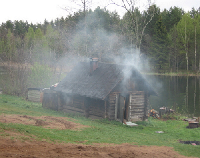
Over time, the bath in black began to improve. The first step on the path to progress was the replacement of the hearth with a half-part - a plate with a neck, which was first closed with a flap and then a door. The slab itself was built from a “wild stone” on clay basis, its sides were also covered with stone, and a barrel or cauldron filled with wild stone was built into it from above. While the stove was heated, they were open. Water, as before, was heated by hot stones. Then in the baths began to put these furnaces - with a pipe. There are also devices for water heating - forged iron strips attached at one end in the furnace body. The second end of the strip was immersed in a barrel of water. Then they began to heat the water with an iron pipe, which was inserted into the stove, and its ends were welded to the barrel. The heater itself moved to the far end of the stove, and a pipe with a flap began to be located above it.
Over time, the waiting room turned into a real room with a door, windows and a wooden floor. In the dressing rooms were placed benches for clothing. Also, the butt ends of the furnaces for space heating were brought to the waiting room.
Baths have become higher, because the shelves have risen up. They began to attach attacks to them so that it was more convenient to climb onto the shelves, as well as those who could not stand a real pair by age or unhealthiness could steam up on the steps.
Features and benefits of a bath in black
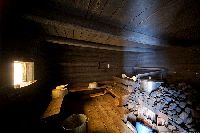
A few really know how to really stoke a bathhouse in black. Black baths in Siberia are especially common, and every true Siberian bath connoisseur will confirm that it is difficult and responsible to heat a bath in a black way. Despite the fact that the sauna in black requires a lot of wood, its costs are minimal compared to other types of baths, and the heat in the heated bath remains for a very long time.
As already mentioned, the black-bath is not equipped with a pipe and all the smoke remains inside the steam room. When building such a bath, first of all, one should pay attention to the good thermal insulation of the floor, walls and ceiling. The windows in such a bath should be thick, in two or three glasses, and the door is very low. in black is also different from the usual. Firewood in it is placed on a special lattice with stones and burns in such a way that the smoke fills the steam room, flowing around the stones. Despite the fact that the soot settled on the walls may seem ugly and dirty at first glance, we should not forget that it absorbs unpleasant odors perfectly, and in order not to get dirty with soot during washing, it should be cleaned from the walls before starting to steam. This feature of the black bath is reflected in its entire structure, which requires considerable skill of the builder - after all, soot should settle only on the walls, but not on the ceiling or on the floor.
The walls in the black bath should be log - they perfectly retain heat and do not allow air to stagnate. Despite the fact that the door of the bath is usually tightly closed, the air inside the steam room is updated at least 7 times an hour, but, surprisingly, the heat in the bath remains for a long time. Therefore, even in the northern latitudes such a bath is very profitable and economical.
As already mentioned, soot in the bath should not be afraid, it performs an important function of disinfection and absorption, and in order not to get dirty in soot, the walls can be brushed with a broom, and rinse the benches and shelves with water. It is better to heat the bath with birch or aspen wood - they give a pleasant aroma and little soot.
A black sauna, not equipped with a pipe, has a number of advantages over a bath with a pipe - a white bath.
First, building a bath in a black will cost less and requires less effort. It is not necessary to remove the pipe through the wooden structures of the ceiling, which is very difficult from the point of view of fire safety.
Secondly, the bath in black is faster and better heated due to the fact that the heat from the furnace does not go into the pipe, but is distributed inside the room.
Thirdly, a black sauna, especially a recessed bath, requires less firewood than a white bath, and it doesn’t need to be heated all day, 3 hours will be enough.
And one more important plus. A bath in black has long been famous for its aroma - wooden walls and ceilings fragrant with floor or grass covering floors. And in the bath in a white way, in order to feel the herbal aroma, you need to water the hot stones with a pre-stored broth or at least steam a broom.
And still the bath in black attracts with mystery and legendary halo. After all, since ancient times, rituals were held in the bathhouse - babies were taken to the bathhouses and the dead were taken to the last journey, the girls went to the bathhouse, and experienced witches boiled magic decoctions in the bathhouses ...
|| Well construction || Secrets of the use of Russian bath || Recipes recovery | | Medicinal herbs with medicinal baths || Herbal Vitamin TeaA black bath is an old Russian bath, which was used by our ancestors for many, many years, and even now this type of bath is still preserved in northern Russian villages and in Siberia. It is a log cabin in which the steam room and the washing room are combined. The heating of the room is carried out from the fire, which burns in the hearth, usually located in the center of the room under a pile of stones.
Fig. one.
The pipes in the sauna are not black, and the smoke from the furnace, passing through stones that accumulate heat, circulates around the room, heating the walls and the ceiling, and then leaves through the holes in the roof (ceiling) and walls, as well as through the half-open door. The ceiling and walls in such a bath are always smoked, hence the name of the bath - in black. When the bath is exhausted, after complete combustion of the wood, the remaining heads and coals are thrown into the yard. Then close all the holes through which smoke came out of the hearth. The bath should stand for an hour and a half, for carbon monoxide to escape; after that the walls are doused with water, the floor and shelves are washed. For steaming the baths, they must be placed on heated stones with one or two scoops of water.
In the remote villages of Russia you can still find baths, partially or fully embedded in the ground, which are also drowned in black. The walls of such a log bath, they retain heat well, while ensuring constant air circulation. When the door is closed, the air in the bath is replaced 6-7 times per hour. Surprisingly, the heat inside the bath remains for a long time. This bath is very economical, even in the severe northern frosts, it does not require a lot of wood. At the entrance, arrange a porch, over which stands the roof of the bath, forming a canopy. The porch is usually made with log walls and, thus, it can be used as a dressing room and a storehouse for firewood.
You should not be afraid of soot in a bath in the black way, basically only walls and ceilings are smoked in it; benches, shelves are not shrouded in smoke and remain clean. To fully guarantee them enough to drench with water. If only birch or aspen firewood is used, then very little soot is formed during their combustion. Soot available in the bath is useful in that it absorbs all the bad odors, soot literally disinfects the room of the steam room. A sauna in black, without a pipe, has a number of advantages over a bath in white, in which a pipe is opened to release smoke. The black sauna is simpler and cheaper to build, you do not need to pull the pipe through the wooden structures and at the same time observe strict fire safety rules. The walls of the sauna in black are heated faster and stronger, as the heat from the stove-heater, passing through the stones, does not fly out into the chimney, heating the white light, but spreads inside the room and warms everything up. There is much less firewood for such a bath, especially for the buried one, it is necessary to drown the black bath not in the morning, like white, but only two or three hours. In the sauna, black smells much more and more pleasant smells from the log walls, the ceiling, fir branches and herbs scattered in advance; the air in it is literally saturated with aroma. In the bath on the white smells and aromas appear only when steamed broom or splash on the hot stones decoction of herbs.
The author was fortunate enough to steam several times in the black-bath bath at the end of the fifties, when he was still working on an oil exploration drilling rig in the northern taiga. A friend of fishing invited me once on a Saturday bath day to himself, to a village located on the high bank of the Pechora. The bathhouse was not a buried, ordinary log cabin, but it was heated in black. The bathhouse was heated with the door open, the smoke was shrouded in it from all sides, and the first thing that was thought was the bathhouse? The sight was amazing. More than forty years have passed, but the impressions of visiting this northern bath are still fresh in the memory of the author.
The black sauna attracts with its romance, there is something ancient, primitive, fabulous in it, and it was not in vain that in ancient times girls came to the black bathhouse. Bath on white - it is very easy to make a black bath, if it is not to the taste of any family or if the family has enough wealth. For this, it is necessary to equip the stove with a vault, remove the pipe, and that’s all - the bath is ready for white. In fig. 2 shows the simplest country bathhouse in white, consisting of only two rooms: a waiting room and a steam room.
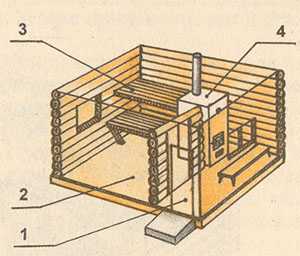
Fig. 2 The simplest Russian village bath in white: 1 - a waiting room; 2 - steam room and washing; 3 - shelves; 4 - oven
A bath in white, when it is built right away, is usually more comfortable: a warm waiting room is always made, chopped from logs along with the bath. The dressing room is heated by the heat of the heater through the hole, the wall of the heater or the heater. They also try to make the floor of the waiting room warm. In a comfortable bathhouse on white there is a room for washing, equipped with a shower and preferably a bath. The size of the bath on white, its layout and decoration depend on the financial capacity of the family, the wishes of its members.
A waiting room in the family bath should also serve as a rest room. Here are satisfied with wide and long benches, covered with some thick and soft material (koshma, sheepskin), with mandatory sheets, towels and pillows. A table with a samovar, jugs of kvass, berry water, and juice is located near the benches. Well, if a swimming pool is arranged around a bath, a river flows or a pond or lake is located.
After a good bathing procedure, a “wolfish appetite” usually appears, and it will not prevent your health from finishing the bathing ritual with a lunch or dinner of light vegetable snacks, fruits, and refreshing drinks. Fragrant hot tea with donuts and cheesecakes - that goes without saying. In a white bath, the threat of carbon monoxide poisoning is not excluded, and to avoid this danger, the following rules must be followed: when the bath is exhausted and sufficiently heated, carefully mix the coals in the firebox so that even a small smoldering fire remains. If there are large smoldering little heads in the firebox, they should be removed from there and extinguished in a bucket. From the blower, the stoves also need to be cleaned up, since there can be long-lasting embers there.


